"Stepping onto foreign shores, leaving behind familiar landscapes, and embracing the promise of a new horizon, this was the journey that defined Arthur Charles Willats, my 3rd Great Grandfather Uncle. His arrival in America wasn't just a geographical transition; it marked the inception of a legacy woven with resilience, ambition, and the pursuit of dreams.
From the cobbled streets of London to the vast expanse of America's possibilities, the life of Arthur Charles Willats is a saga painted with the hues of adventure, resilience, and unrelenting passion. Part 2 of his tale takes us through the riveting chapters of his American odyssey, a journey marked not only by geographical transition but by the forging of an indelible legacy. Arthur's sojourn in the New World wasn't merely a change in location, it was the canvas upon which he painted a life rich in experience, love, and relentless pursuit of his passions, an insatiable appetite for knowledge and the arts. Through the triumphs and trials, Arthur's legacy continued to flourish in the New World, shaping generations with his wisdom, artistry, and unyielding dedication to education and of course the stage. Join me as we unravel the extraordinary saga of a man whose life journeyed through loss, love, and an unquenchable thirst for enlightenment, culminating in a legacy that transcends time itself."
So without further ado, I give you,
The Life Of Arthur Charles Willats
1863-1933,
Part 2,
Embracing The Promised Lands.

Welcome Back to the year 1886, where Arthur and his new wife Josephine Mary were beginning their married life in Buffalo, Erie, New York, United States of America.
In 1886, Buffalo, New York, was a city marked by industrial growth and economic prosperity. The atmosphere was bustling, with the Erie Canal and railroads contributing to its status as a major transportation hub. Industries such as grain milling, steel production, and manufacturing thrived, attracting immigrants seeking employment opportunities.
Social classes were quite distinct. The upper class, comprised of industrialists, bankers, and successful merchants, enjoyed lavish lifestyles and lived in opulent homes in neighborhoods like Delaware Avenue. The middle class, including skilled workers, teachers, and small business owners, experienced a comfortable lifestyle but lacked the extravagant wealth of the upper class. The working class, made up of labourers in factories and docks, faced challenging conditions with long hours, low wages, and poor working conditions.
The city’s population saw a mix of cultures, with a significant influx of immigrants, particularly from Germany and Ireland, contributing to the diverse tapestry of Buffalo. Ethnic neighbourhoods began to form, fostering tight-knit communities that retained their cultural traditions while adapting to American life.
1886 was marked by significant historical events. The Statue of Liberty was dedicated in New York Harbor, a symbol of freedom and democracy for immigrants arriving in the United States. The Haymarket Affair in Chicago brought attention to the labor movement and issues of worker rights, sparking debates about labor conditions and unionisation across the country.
Social movements advocating for women’s rights and temperance gained momentum. Suffragists worked tirelessly for women’s voting rights, and temperance groups campaigned for the prohibition of alcohol, leading to the eventual passing of the 18th Amendment in 1919.
However, despite the city’s prosperity, challenges existed. Political corruption was prevalent, and the gap between the wealthy and the working class continued to widen. Labor strikes and tensions between workers and industrialists were not uncommon, highlighting the growing discontent over working conditions and wages.
Overall, life in Buffalo in 1886 was marked by industrial growth, cultural diversity, social stratification, and ongoing societal changes that would lay the groundwork for future developments in labor rights, urban development, and social reforms.
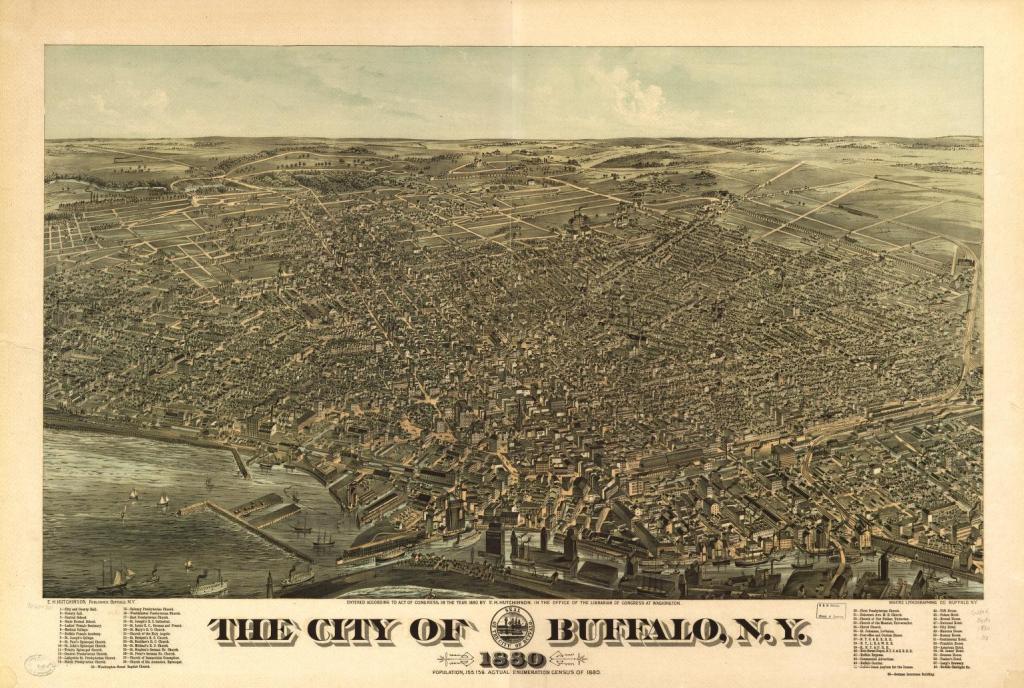
It's from the Buffalo City Directory, we know that Arthur and his wife Josephine was residing at Number 145 Franklin Street, Buffalo, Erie, New York, United States of America and Arthur was working as an Actor. Josephine was named as Mrs Josie Willats. Josie has the word Boarding listed where her occupation should be. I am lead to believe this means Boarding stables.
The 1886 Buffalo City Directory was issued on the 1st of January 1886.


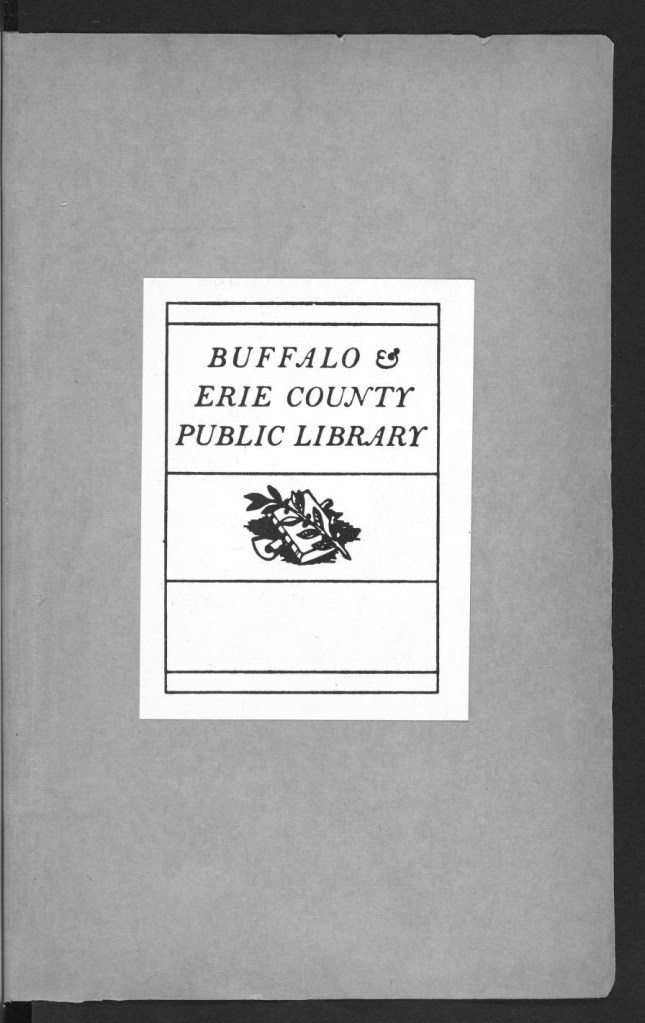

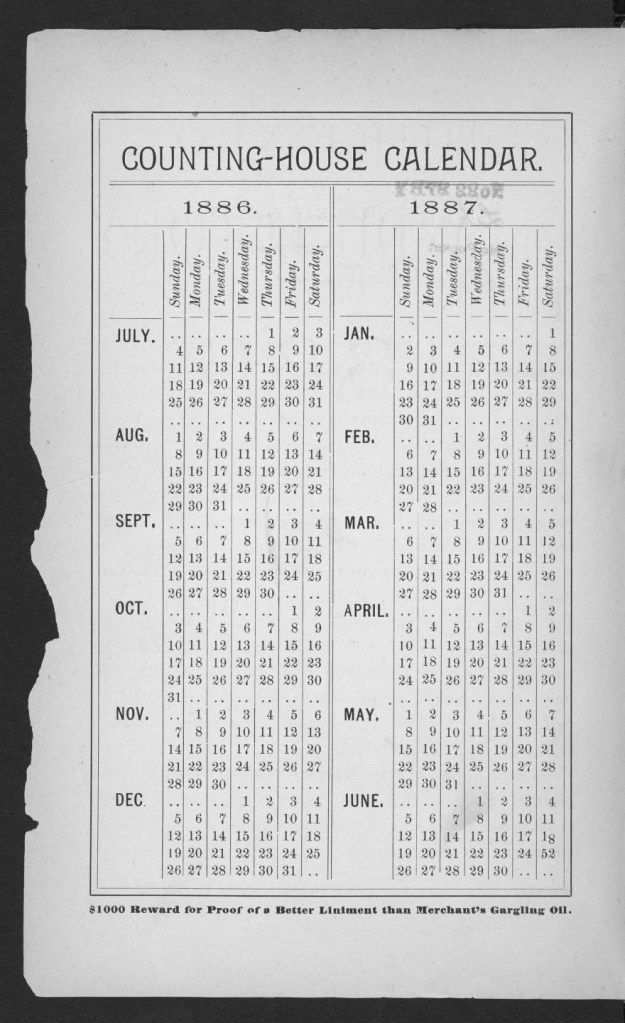

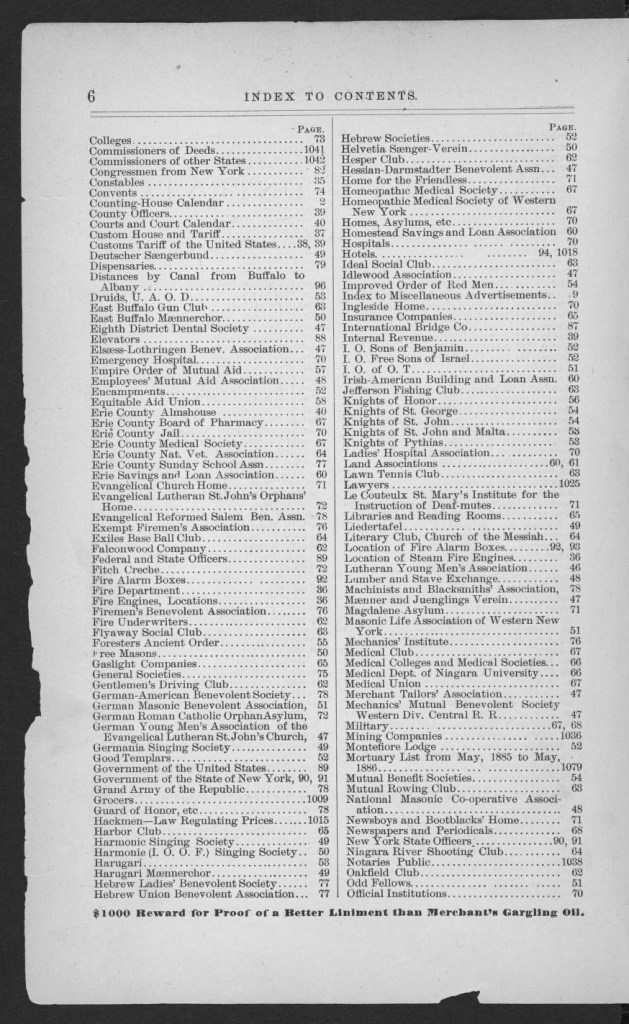
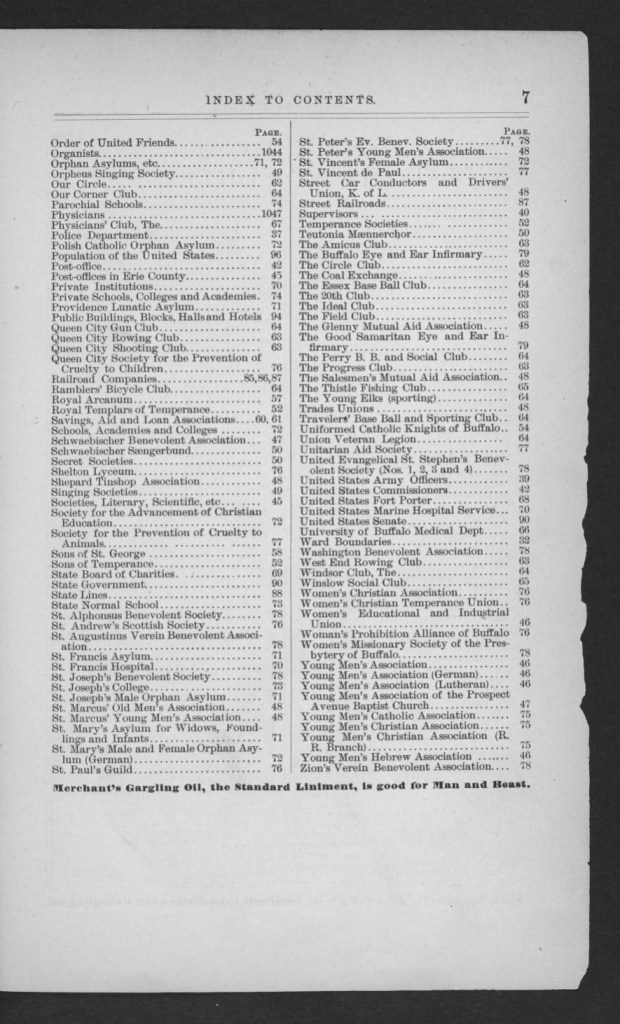
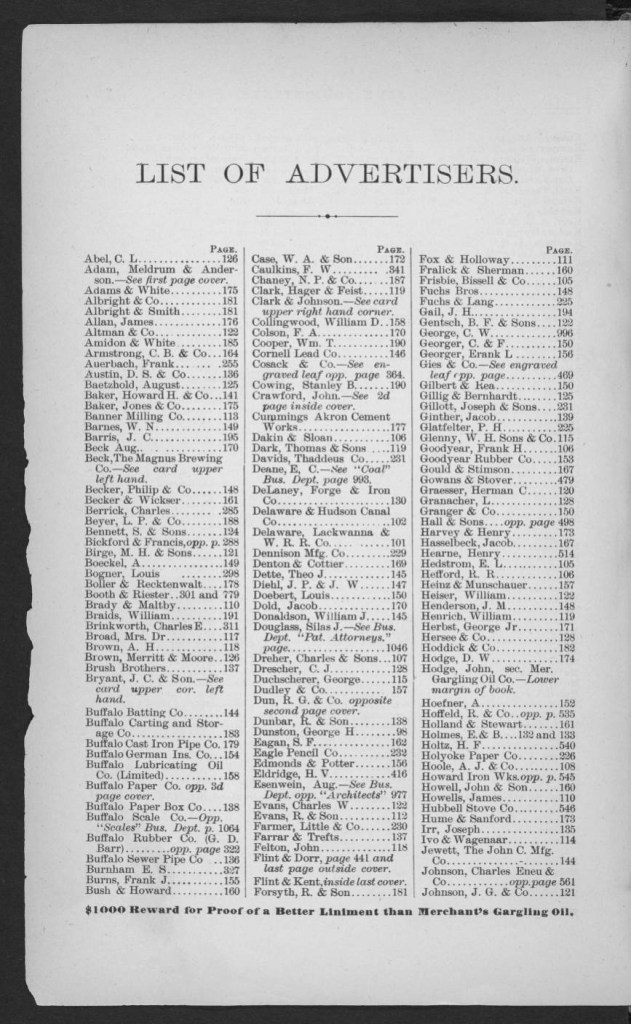
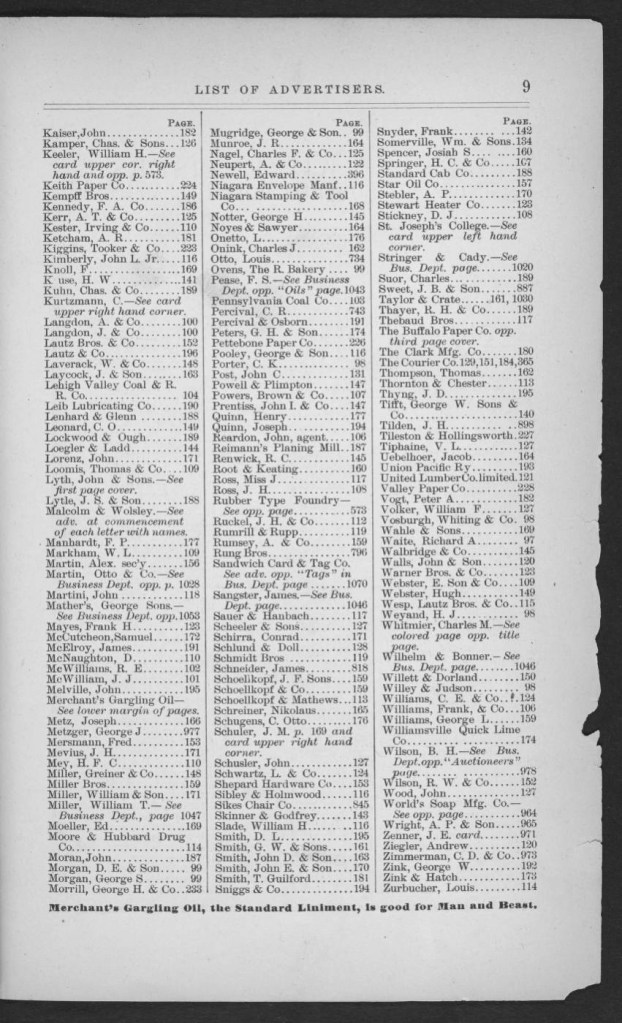



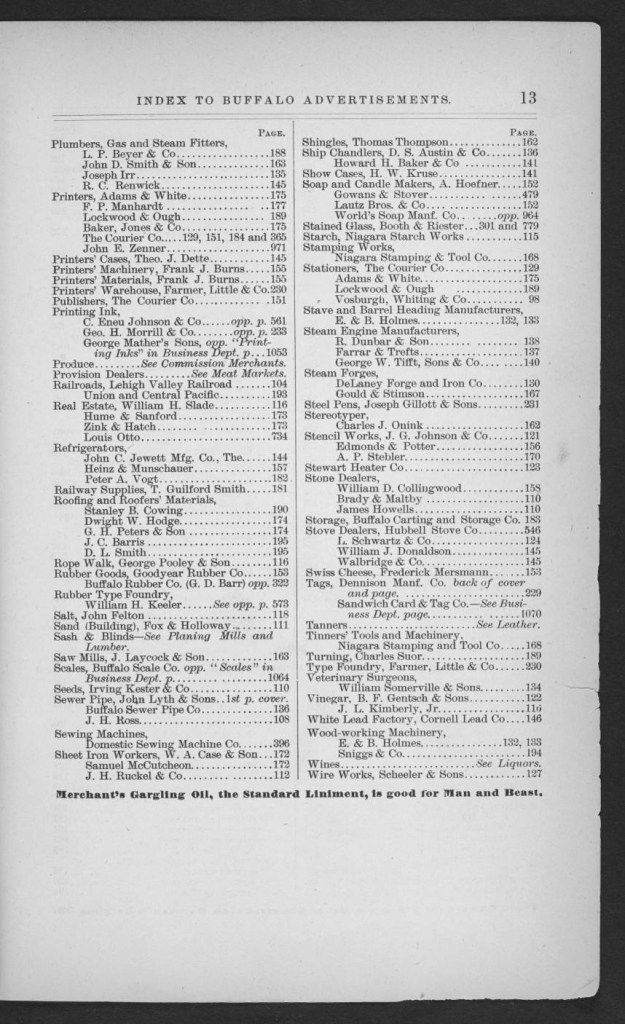

From the 1910 US Census, we know, Arthur and Josephine’s daughter Beatrice Josephine Willats, was born on the 19th of August 1890 in Buffalo, New York, USA. (census will be shown later.)
Arthur, Josephine, and their daughter Beatrice, were residing at Buffalo, Erie, New York, United States Of America, on the 16th of February 1892, when the 1892 New York State Census was completed. It’s States the Arthur was 30 years old American citizen from England and he was working as a Cyclorama manager.
| Name | Arthur C Willats |
|---|---|
| Birth Year | abt 1862 |
| Birth Place | England |
| Age | 30 |
| Gender | Male |
| Citizenship | Citizen |
| Residence Place | Buffalo, Erie |
| Ward | Ward 20 |
| Election District | 02 |

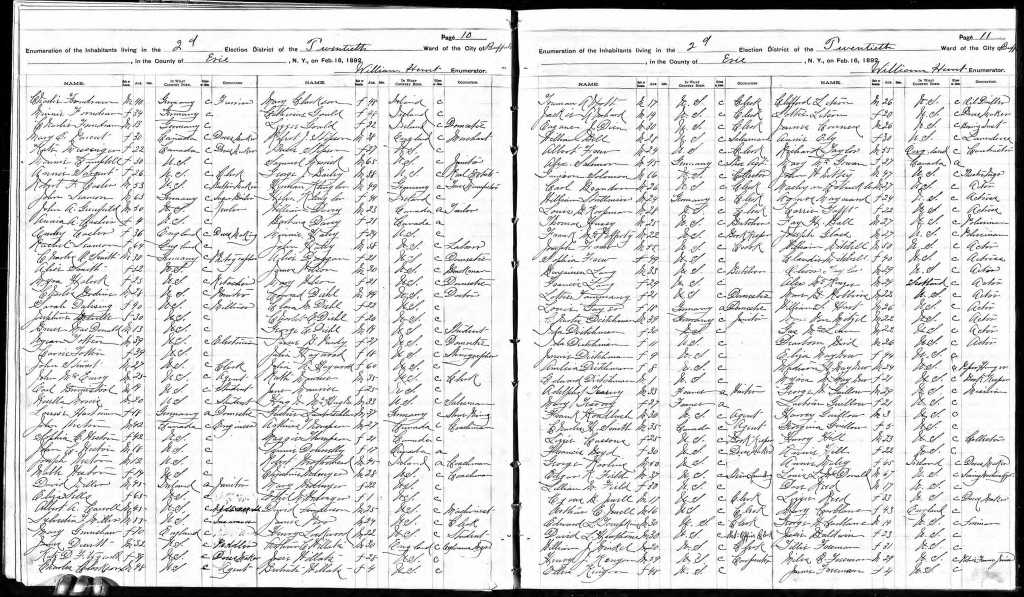
The 1892 U.S City Directories, shows us that Arthur was residing at Number 281 Pearl Street, Buffalo, Erie, New York, United States of America in the year 1892. It shows Arthur’s occupation as Boarding (Boardings Stables).

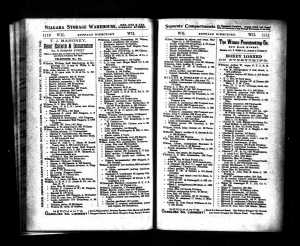
Arthur and Josephine’s son was born on the 26th of March 1892, in Buffalo, Erie, New York, United States of America. Ancestry unfortunately doesn’t seem to have any of the birth Index’s for Erie, New York. I have found a site that I can order birth certificates from but unfortunately they want just under $80 for one certificate. I can not warrant spending that, it’s a ridiculous amount of money for a certificate.
Arthur was mentioned in an article called, “An Appointment” in The Buffalo Commercial on Tuesday 17th May 1892.
It reads,
An Appointment.
Mr. Arthur C, Willats, formerly of the Cyclorama company, has been appointed advertising and press agent of the Crystal Beach Steamboat and Ferry company.

The 1893 U.S City Directory, shows us that Arthur was residing at Number 281 Pearl Street, Buffalo, Erie, New York, United States of America in the year 1893. It shows Arthur’s occupation as Boarding (Boardings Stables).

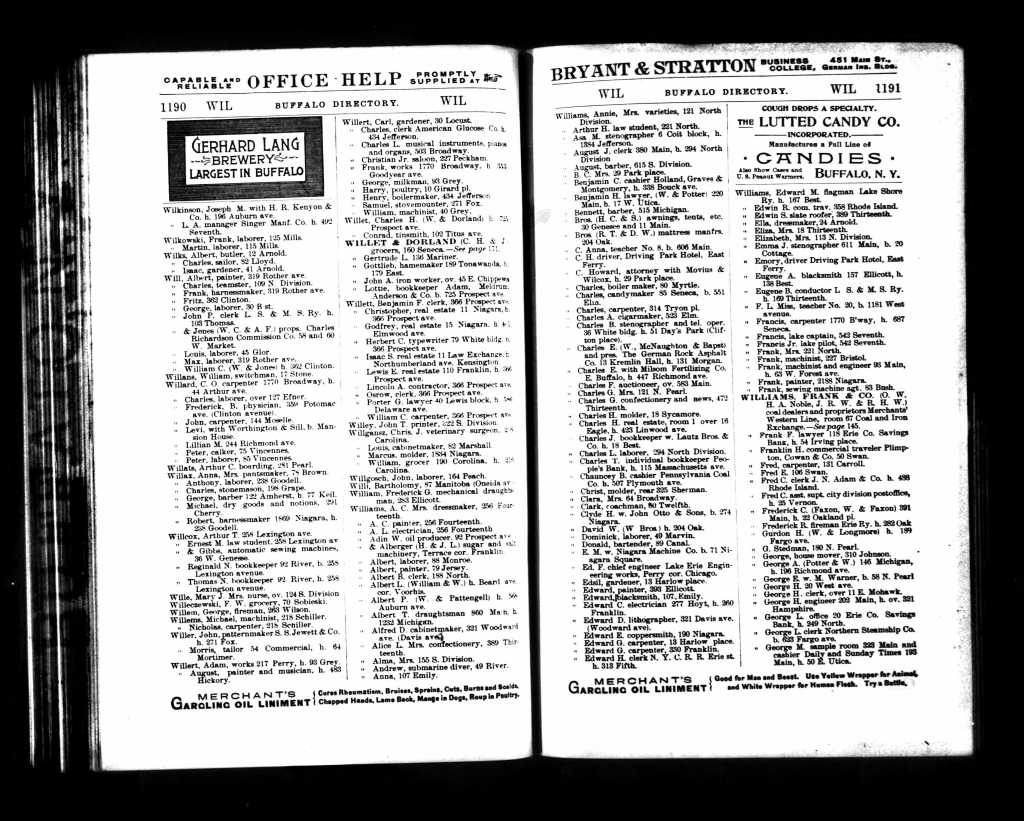
Generally a city directory will contain an alphabetical list of citizens, listing the names of the heads of households, their addresses, and occupational information. Sometimes a wife's name will be listed in parentheses or italics following the husband's. Other helpful information might include death dates for individuals who had been listed in the previous year's directory, names of partners in firms, and forwarding addresses or post offices for people who had moved to another town.
There are usually several parts to a city directory. The section of most interest, of course, is the alphabetical listing of names, where you may find your ancestor.
In addition to the alphabetical portion, a city directory may also contain a business directory, street directory, government directory, and listings of town officers, schools, societies, churches, post offices, and other miscellaneous matters of general and local interest. These sections can help you become more familiar with the city or county your ancestor lived in. If your ancestor owned a business, be sure to check the business section for advertisements.
Whenever you use a directory, it is important to refer to the page showing abbreviations used in the book. Some abbreviations are quite common, such as h for home or r for residence. There may even be a subtle distinction between r for residents who are related to the homeowner and b for boarders who are not related. Becoming familiar with these abbreviations will help you better interpret your ancestor’s listing.
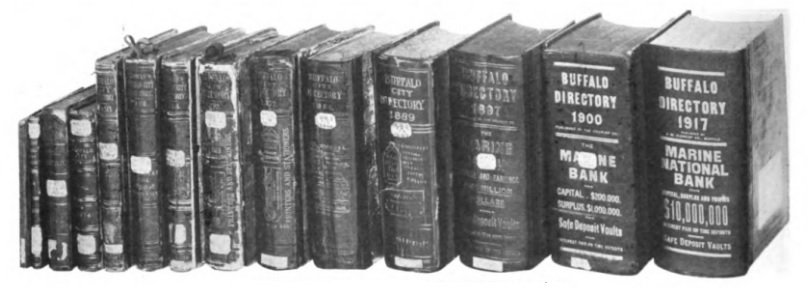
From the 1890-1960 UK and Ireland, Outward Passenger Lists, Arthur departed from Southampton Docks, Southampton, Hampshire, England, on Saturday the 10th of November 1894, aboard the Ship “New York.” He gave his occupation as a Labourer. The Master of the ship was named John C Jameson.
| Name | A C Willats |
|---|---|
| Gender | Male |
| Departure Age | 31 |
| Birth Date | abt 1863 |
| Departure Date | 10 Nov 1894 |
| Departure Port | England |
| Ship Name | New York |
| Destination Port | New York, USA |
| Master | John C Jameson |
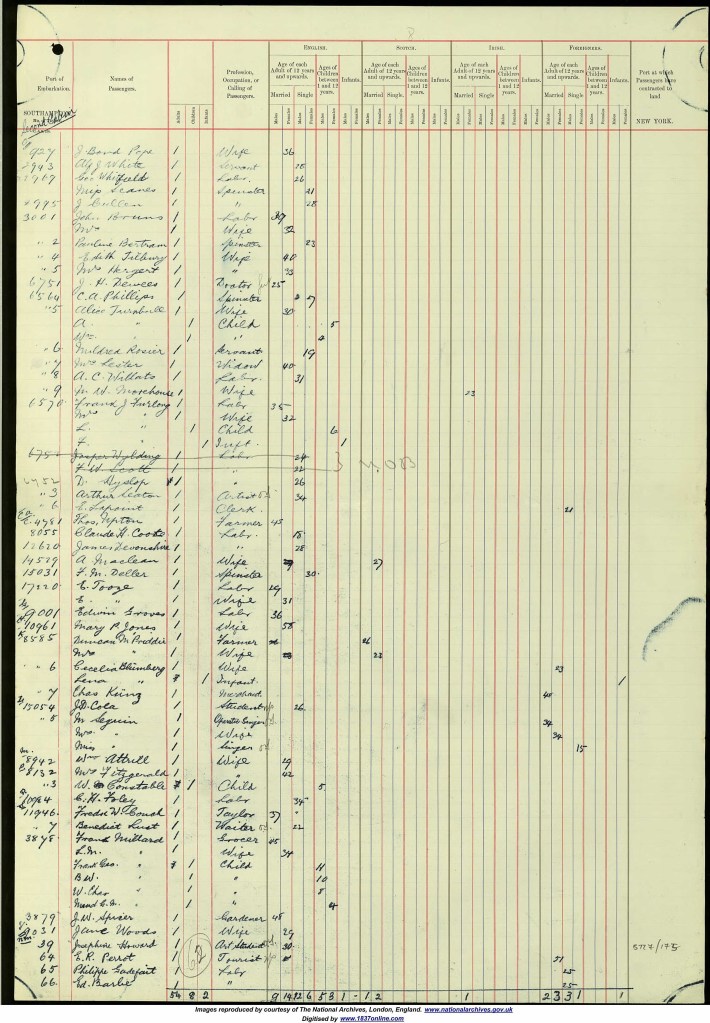
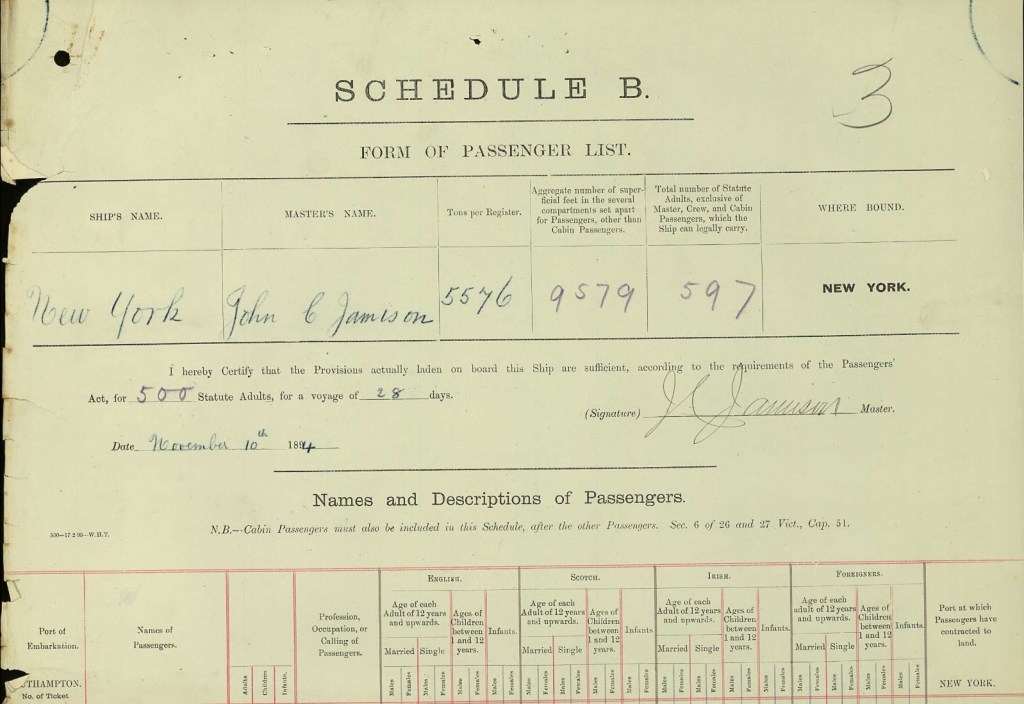
The New York ship was in service from 1893 to 1898. It had 3 Funnels, 3 Masts and 3 Aliases. The New York was a American Shipping Line and was Built by J. & G. Thomson, Ltd., Clydebank, Glasgow, Scotland. Her Tonnage was 10,499, her Dimensions were 528′ x 63′ (560′ o.l.), Twin-screw, 20 knots. She has a Steel hull and Clipper bow. Her first voyage was from New York Southampton to New York, on the 11th of March, 1893. New triple expansion engines were installed in 1903. She was renamed: (a) Harvard (1898), (b) New York (1899), (c) Plattsburg (1917) United States Government, (d) New York (1919) American Line. She was sold to Polish Navigation Company in 1921 and Scrapped at Genoa in 1923.
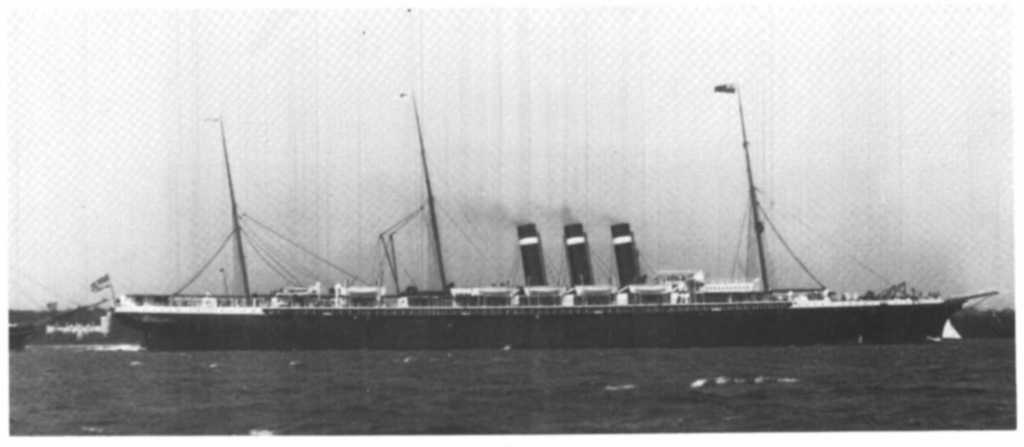
From the 1894 New York, US. Arriving Passenger And Crew Lists, we know that Arthur arrived back in New York, United States of America on Saturday the 17th of November 1894, aboard the Ship “New York” which departed from Southampton, Hampshire, England. Arthur was a 31-year-old, Artist and was an American citizen. He gave his native country as, America and his destination as New York. He had 3 luggage bags with him.
| Name | A C Willats |
|---|---|
| Gender | Male |
| Ethnicity/ Nationality | American |
| Age | 31 |
| Birth Date | abt 1863 |
| Departure Port | Southampton, England |
| Arrival Date | 17 Nov 1894 |
| Arrival Port | New York, New York, USA |
| Ship Name | New York |


It is very possible that Arthur’s trip back to England was to say goodbye to mum Eliza.
As back in England, Arthur’s mum, Eliza Willats nee Willats Formerly Cameron, passed away on Friday the 23rd of November 1894, at Number 27, Kings Road, South Hornsey, Edmonton, Middlesex, England, when she was 59 years old. Eliza died from, disease of valves of the heart two years nine months and dropsy. Her daughter Edith Charlton of Number 27, Kings Road, South Hornsey, was present and registered Eliza’s death on the 26th of November 1894.

The Willats family, family, laid Eliza to rest, in, Abney Park Cemetery, 215 Stoke Newington High Street, Stoke Newington, London, England, N16 0LH, on Thursday the 29th of November, 1894, in D06, Grave 092431. Her abode was given as, Number 27, Kings Road, Brownswood Park.

When Eliza died Walter’s father, Richard Henry, purchased 2 graves in Abney Park Cemetery, which was then the beautiful garden of a big house turned into a private cemetery. Each grave cost, 3 guineas and took six interments. I can not confirm if Arthur was present or not but from the NewYork and Uk passenger lists it looks like he wasn’t.

A letter Arthur wrote to E. H. Butler, Esq , Evening Newswas printed in an article called, “ It Was A Great Success.” in The Buffalo Evening News on Tuesday the 18th of February 1896.
It reads,
IT WAS A GREAT SUCCESS.
When the Mercury Was 10 Below Zero “News" Coupons Filled the Ice Chute
Rink With Skaters.
The following from Mr. Willats, manager of the Buffalo Chute Ice Rink, sufficiently emphasizes the story of the Buffalo boys and girls who came out to skate by the light of the moon and electrics last night when the mercury was away down 10 degrees below zero and the musicians were disabled from time to time by their lips freezing to the mouthpieces of their instruments:
Buffalo, N. Y., Feb. 18, 1896.
E. H. Butler, Esq , Evening News
My Dear Mr Butler -To say your coupon day at our ice rink was a grand success is expressing it coldly.
I had the pleasure of running a coupon day for you some five years ago, while lecturing and managing that wonderful picture, “Jerusalem, on the Day of the Crucifixion.”, at the Cyclorama Building, Edward and Main streets.
Should you refer to past records, you will find that 6621 people visited the Cyclorama in the one day, and every one had a coupon cut from the NEWS.
This occurred in the early part of September. Once more I find myself hustling for the NEWS. But this time instest of the thermometer being zero it registered in the neighbourhood of 10 degrees below zero, but, nevertheless, in my opinion, a greater success than the 6621 above recorded. We had during yesterday afternoon and evening 1408 actual skaters on the ice. Thus another record is made by your wonderful newspaper. I never imagined that people thought so much of the NEWS as to come out at its invitation at 10 degrees below zero and skate. Had it been about freezing point we would have had a difficult time handling the crowds was naturally towards evening the ices was very much cut up, which kept us very busy flooding until 4 A. M.
Happily the ice is once again in perfect condition. Our band had the misfortune to freeze up twice, and is longing for warmer weather Saturday.
Wishing the NEWS every, prosperity, with kindest regards. Yours very faith-fully,
ARTHUR C. WILLATS,
Manager Bufalo Chute Ice Rink.
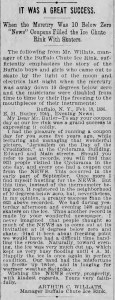
Arthur was mentioned in a Article called “RACERS AND A "BLAT." which was printed in Buffalo Courier on Wednesday 8th July 1896. Below is part of the article that mentioned Arthur.
It reads,
“RACERS AND A "BLAT."
Quartette of Cyclists Are Chased Off the Track.
THE SHEEP VICTORIOUS.
The Press C. C. Mascot Takes Exception to Certain Riders and Routs the Party-"Blat's" Early Struggies, Whiskers and Training.
At Buffalo Athletic Field, hidden away in the recesses of somewhere, from which place it comes forth anon and distinguishes itself, is a sheep, or more properly speaking a sheeplet. It is the property of Mr. Willats, the genial Englishman, who left Capt. Pani Boynton to cast his lot with the Buffalo Athletic Field and its promotors: He is the sole owner of the sheep, several dogs chickens, and other things. According to Dr. Johnson. the sheep followed its owner as Mary's lamb did and Mr. Willats caught and tamed it. However that may be the lamb is a feature of the Field, and a fixture.
Not long since it was decided that a name should be given to the sheep. A meeting was called, and the executive committer had mutton placed before them, believing that they would get an inspiration. They were right.
The sheep looked at his namers and tore off a long slaughterhouse fat. It was enough, the committee agreed that it should be as he asked, so he was called "Blat."

Arthur was mentioned in an article called “Business Chances.” Which was printed in The Buffalo News on Friday, 4th of December 1896.
It reads,
BUSINESS CHANCES.
TO LET-Refreshment privileges; bids are solicited for the refreshment privilege during the skating season at the Buffalo Athlette Field; all applications should be made to Arthur C. Willats, on the premises.
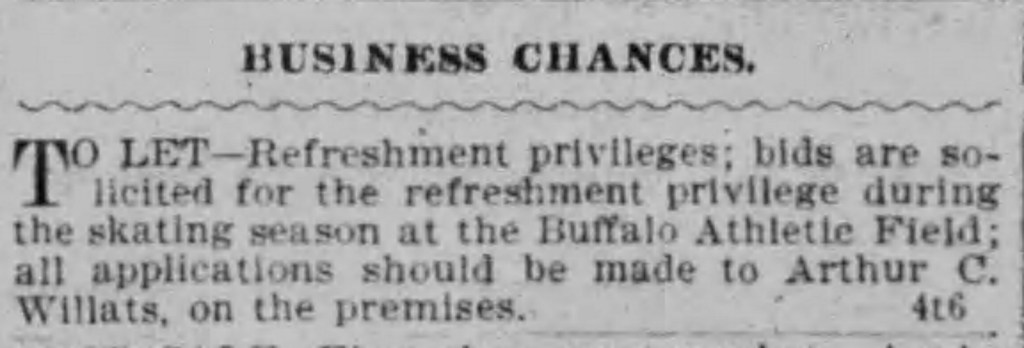
Sadly a few years later, Arthur’s brother, William George Willats (Biggun) died on Sunday the 14th of February, 1897, at 44 Gillespie Road, Islington, Middlesex, England. He died from Cardial Haemorrhage Corona Syncope. Their Sister, Charlotte Ellen Crosbie, of, 132 Wilberforce Road, Finsbury Park, was present and registered his death on the 16th of February 1897.

The Willats family laid William George Willats to rest at Abney Park Cemetery, Stoke Newington, Hackney, London, England on Thursday the 18th of February 1897 in grave D06 092431 with Eliza Willats, Francis Paul Willats, Richard Henry Willats and Percy Sidney Willats. I am unsure if Arthur attended but from the overseas returns I assume he didn’t.

Arthur was mentioned in an article in The Buffalo News on Monday 29th March 1897.
It reads,
SHOULD MAKE IT POPULAR.
C. A. Johnson to Have Sole Management of the Buffalo Athletic Field.
Now that Charles A. Johnson, the owner of Buffalo Athletic Field, has escaped the toils of his enemies by cleaning off the mortgages against his property, the perpetuation of the Field as an athletic ground is an assured fact and the cycling clubs of the town are casting envious eyes In its direction. One proposition that has been heard is that the Associated Cycling Clubs of Buffalo secure the management of the Field for the coming summer.
This might be a good scheme and no doubt would work well, but other arrangements have been made. TheNEWS knows from authoritative sources that Mr. Johnson will retain control of the Field himself this season, and proposes to make it even more popular than ever with cycling and athletic clubs. It is Mr. Johnson's intention to come to Buffalo and give the Field his personal supervision. He will have an office down town, while Arthur C. Willats will continue to act as his representative at the Field.
The property was originally purchased with the idea of building a water chute on it, and this idea will now be carried into effect. Mr. Johnson intends to expend something like $25,000 on the chute and it will be modelled on the plans of the Coney Island affair.
The chute will be built up over the entrance and will terminate in a lake located on the Main Street side behind the bleachers, but will in no way interfere with the bicycle track or football grounds.
The grounds will be open for any kind of athletic engagements and considerable money is to be spent in putting the track and football portion in the best of condition. It is also intimated that a sprinting path may be constructed just inside the bike track.
Mr. Johnson comes to Buffalo with the reputation of being a man of business, although like many other businessmen he has been unfortunate the last couple of years.
With one man in exclusive possession of the grounds, and no club or clubs sharing in the management, there can be no petty jealousies existing and the Feld should become very popular with the local athletes. Everything will be done that can be done to assist the wheelmen, and Mr. Johnson will attempt to book early several big college football games for next fall.

Arthur was mentioned in the Buffalo Courier, on Wednesday 23rd June 1897.
It reads,
HAMMER THROWERS.
Press Cyclers Not Afraid to Wield the Weapon.
Could Not Getv the Athletic Field at
Their Figures, So They Go to the Driving Park.
On July 5th at the Buffalo Driving Park the Press Cycle Club will run a free bicycle race meet. The track has been leased by the club and the suspension has been raised by the I. A. W. in order that the club could run its annual meet on that date as it has been in the custom of doing for several years past.
This plan was decided on last night at a meeting of the Board of Directors of the Press Cycle Club, when President Baker made known the result of his visit to Baltimore to see Chairman Mott of the L. A. W. Racing Board. He explained to the managers of the club that Mr. Mott had assured him that it would be impossible for anyone else in Buffalo to secure a sanction for that day and that the suspension which has rested on the Driving Park track since the time the women's races were run there would be raised.
After hearing the report the managers decided that they would run a meet at a possible cost to the club rather than lose its right to the L._A. W. sanction for holding a meet on July 4th of each year.
It was the purpose of the Press Cycle Club to hold its annual meet on Buffalo Athletic Field and permission was given to hold the races on that day.
A committee was then appointed to wait on Mr. C. A. Johnson, who is reported to own Buffalo Athletic Field, and ascertain what the cost of the track would be for July 5th.
Mr. Johnson told the committee that he would let them have the track for $750 for that day, but that if they wanted a rain guarantee for the following Saturday it would cost them $150 more, whether it rained or not, making the track cost $900. The blow almost killed the committee but they lived to make a report.
Would Give 8500.
President Baker thought that some better terms might be made and once more the committee appeared before the track owner and told him what the club was willing to do, namely, to give him $500 in cash, providing also for the rain guarantee or 25 per cent of the gross receipts.
Mr. Willats, the manager of the track, said to Mr. Johnson
"turn me loose and let me talk to them." He explained to the committee that the track must net Mr. Johnson et al. $900 for the week Whether it was 1 per cent gross or net,
The committee went back and told its tale of woe and Mr. Baker was sent to Baltimore.
On June 8th Mr. Johnson wrote a letter to Capt. Debo of the Press Cycle Club stating that if the track wasn't rented by 6 o'clock of the evening of the 9th it would be leased to other parties.
Through error or design the letter wasn't put in the postoffice until 11 o'clock on the night of the 1lth and wasn't delivered until the 12th.
The Press Club took it for granted that Mr. Johnson meant what he said and leased the Driving Park. In the meantime Mr. Willats stated that the field had been leased to a fire-works' company for July 5th.
The Press Cycle Club of course deny any intention of throwing a hook into Mr. Johnson, but there is no doubt that they have started a movement which, if it isn't properly taken care of, will lead to the elosing up of the Athletic Field.
Eddie Bald will help the good work along by lending his presence it it is possible for him to get here.
Eddie Bald May Come.
A temporary grand stand will be erected at the Driving Park and it will be made perfectly safe. Work on it will be begun as soon as it is possible to arrange for it and the work of putting the half-mile track in perfect condition will also be rushed.
In order to protect themselves from a rush of all the roughs in the city who never pay to go to any place, program-with a ticket attached, which will admit the bearer to the track, will be sold for ten cents. "It is a matter of principle with us," said President Baker, "and we will follow our custom, come what may. The Press Cycle Club has been, is and will be for some time yet."

Arthur was named in a article called “THE IMPERIALS’ MEET. There Is Much Tall, About the Parsalt Race.” – List of Omeials.” which was printed in The Buffalo Commercial on Friday 30th July 1897. It reads,
THE IMPERIALS’ MEET.
There Is Much Tall, Aboat the Parsalt Race
-List of Omeials.
The members of the Imperial Cycling Club are confident that their meet, which will be held tomorrow at Athletic Field, will be a great success. It is their first venture of the kind, and they have been fortunate in securing the best talent available at the present time. The seats are on sale at the Peter Paul book store. The pursuit race is creating considerable discussion as to the probably results.
The following will act as officials:
Referee, Walt W. Wilson, member New York State Racing Board; judges, Conrad Baer. W. H. Baker, R. Baird, J. M, For. nes, W. G, Humphrey, Dr. C. S. Meahl; timers, W. G. Shack, E. F. Sullivan, M. F. Dirmberger; clerk of course, F. N. Hut-chine; assistants, B. Bloss, Joseph Young: umpires, G. H, Hunt, Henry Baer, A. Mc-Onethy, O. O. Driess; scorers, E. A. Judge, F. Gemmer, H, L. Chamberlin, George Jolley; announcer, Arthur Willats; marshal, J. D. Stevens.
Following is the Mist of events:
One mile novice.
One mile open.
Halt mile handicap.
Pursuit race (invitation). Ramblers and Parksides, Press and Imperials.
Special one-mile professional match race: Al. Weinig vs. C. H. Werrick.
Half mile invitation race: Employes of Philip Becker & Co.

Arthur was mentioned in The Buffalo Times on Friday 6th August 1897.
It reads,
BUFFALO MEN
Will Compete in the Philadelphia Races Today.
EDDIE BALD IS IN FINE TRIM
AMATEURS OF THIS CITY ARE NOT OVER SANGUINE OF SUUCESS.
BIG CROWDS AT QUAKERVILLE
Arthur Willatts Has Secured Bald, Loughead, Sanger, Kiner and Cooper for a $1,000 Match Race to Be Ridden in Buffalo.
PHILADELPHIA, Pa., Aug. 6.-(Special.)-The Buffalo riders at Willow Grove track are not over sanguine of their success on the board track here, yet they are confident that they can hold their own with the majority of the riders.
Earl D. Stevens had several brushes with fast amateurs yesterday and came out at the head.
Eddie Bald did not ride yesterday, he is resting up for the contests today.
He is in fine fettle and will make the fight of his life for the championships.
Goehler arrived this morning.
Walt W. Wilson, Dai H. Lewis, W. H. Baker, Arthur C. Willats, and "Mike" Dirnberger are here, booming Buffalo for the next meet.
Mr. Willatts has secured Bald, Cooper, Kiser, Loughead and Sanger for a $1,000 match race on August 24th on Buffalo Athletic Field. Some of the star amateurs will also go to Buffalo and compete against our cracks.

Arthur was mentioned in an article called “ Cycle Races Next Saturday.which was printed in the Buffalo Courier, on Sunday, August 08, 1897.
It reads,
CYCLE RACES NEXT SATURDAY.
At the Buffalo Athletic Field Saturday afternoon a pursuit race, a tandem race, and other interesting events, will occur. Arthur Willats, who is promoting the meet, will return from Philadelphia tonight, and will probably add one or two more events to the programme.
The pursuit race will be by four of the fastest amateurs, and should prove a drawing card. Popular prices will prevail.
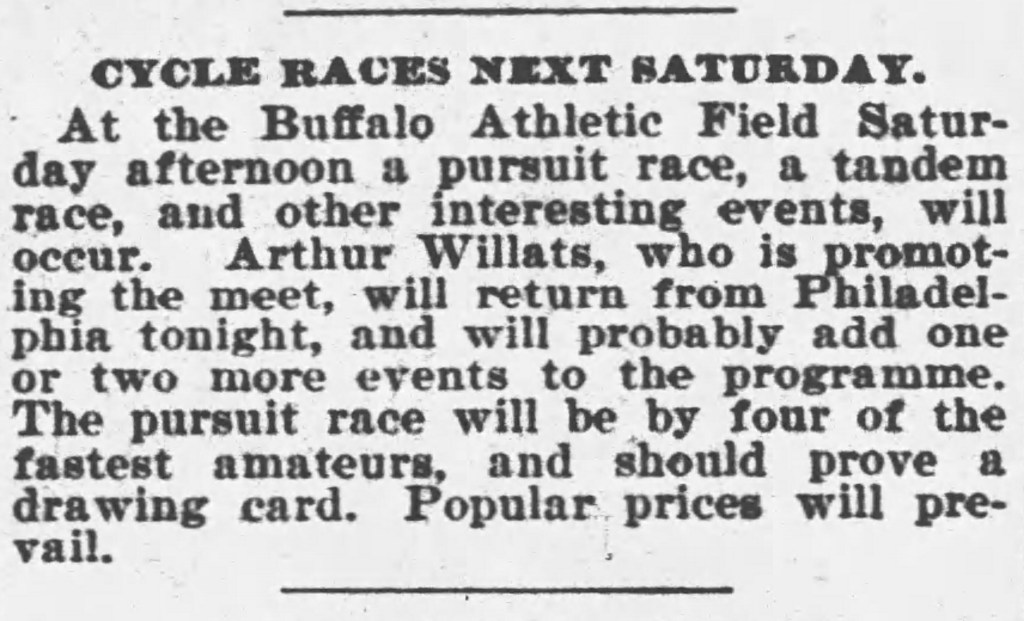
Arthur was mentioned in an article called “BALD VS. KISER.” which was printed in the The Buffalo News on Thursday 2nd September 1897.
It reads,
BALD VS. KISER.
They Will Ride a Match Mile at the National Circuit Meet
Here Sept. 28.
It was today definitely stated that Earl Kiser and Eddle Bald had been matched to ride a mile match race at the Buffalo Athletic Fleld at the Natlonal circuit meet, Sept. 28.
When Bald was beaten here last month by Kiser there was talk of "team work," and a challenge was the result. Bald stated that he would rather ride on the Athletic Field track than any other in the country, and Kiser said he would, too. Manager Arthur Willats has also arranged a mile open, a mile handicap and a two-mile handicap for professionals for the circuit meet.
Kiser will also go against his own record for mile or half-mile, and Bald will probably ride an exhibition mile.

An artist's impression of Arthur was featured in the Buffalo Courier, on Sunday, the 10th of April 1898.
It was featured in a very long article, but as far as I can see there is nothing written about Arthur in the article. 🤔
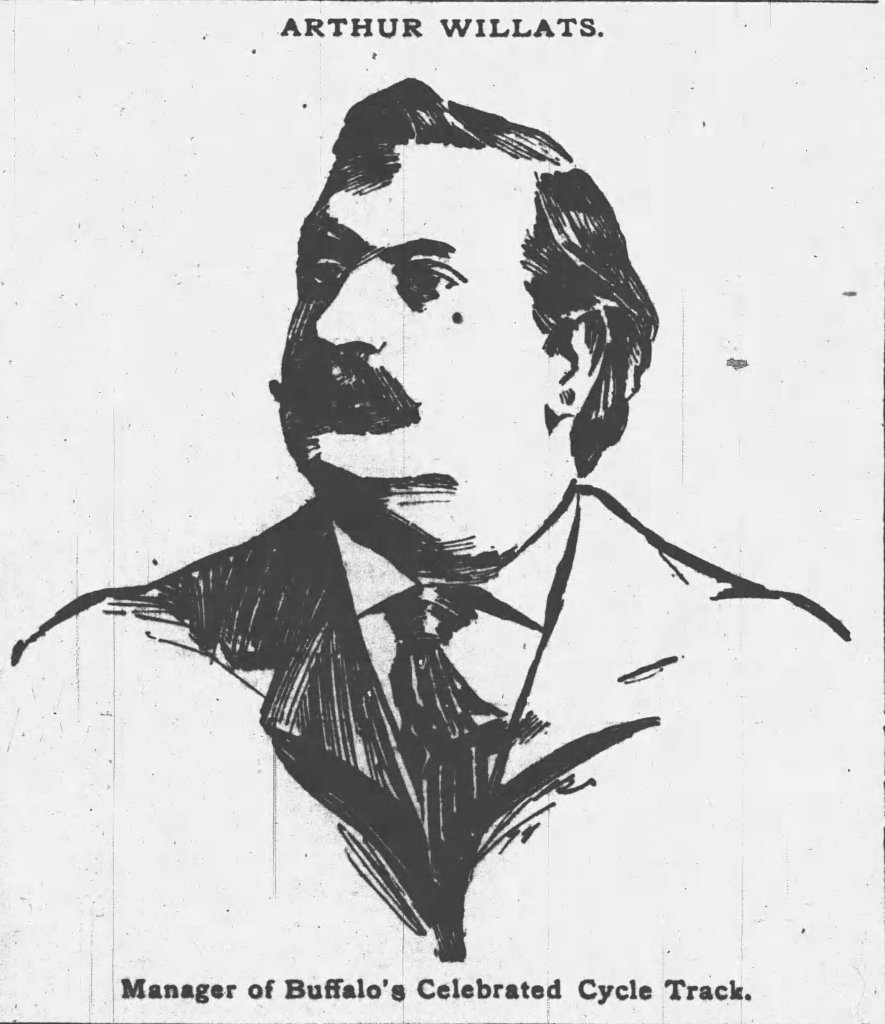

Arthur was mentioned in an article called, “EDDIE BALD WILL RIDE.” which was printed in The Buffalo Courier on Sunday 29th May 1898.
It reads,
EDDIE BALD WILL RIDE.
Champion Wants a Big Price for an Exhibition.
Eddie Bald was signed yesterday by Manager Willats of Athletic Field to ride an exhibition mile against time at the meet of June 9th, which is the National Circuit date.
Bald also sent his entries for all the professional events.
Very few promoters this year can afford to give the champion what he asked even for an exhibition, but Manager Willats intends to have his meet one of the best and best and most successful of the circuit and he is not sparing any expense to make it right.
Entries for the meet should be made early so that arrangements can be made for special events if the riders are shy. As this is a National Circuit meet there will be no lack of material for all the events on the programme.

Arthur was mentioned in an article called “EDDIE BALD'S TASK.” which was printed in The Buffalo Commercial on Tuesday 7th June 1898. I have typed out the part that Arthur was mentioned in.
It reads,
Manager Arthur Willats, of the Buffalo Athletic Field, went to Rochester last night to see the racing aggregation there. He will try to induce all of the circuit chasers to stop over in Buffalo from Thursday to Saturday so as to compete In both meets at the Athletle Field. He will probably succeed, except in the case of Eddie Bald, who has a match race with T. B. McCarthy, of St. Louls, on Saturday. Cooper, the two Butlers, McFarland, Stevens Freeman, Taylore, and the other pros will stop here until Saturday and will compete in both meets.
There is much speculation about the showing Bald will make in the big race on Thursday, and it is hard to find even money that the Bullalo boy will win. Unfortunately. Manager Willets has been notified by Chairman Mott, of the Racing Board, that multleycles will not be allowed for pacing purposes in the national one-mile race.
It was Mr. Willats's intention to mount speedy pros on the big machines and have them thus pilot the celebrities around In fast time, but this plan had to be abandoned, and single machines would be used instead.

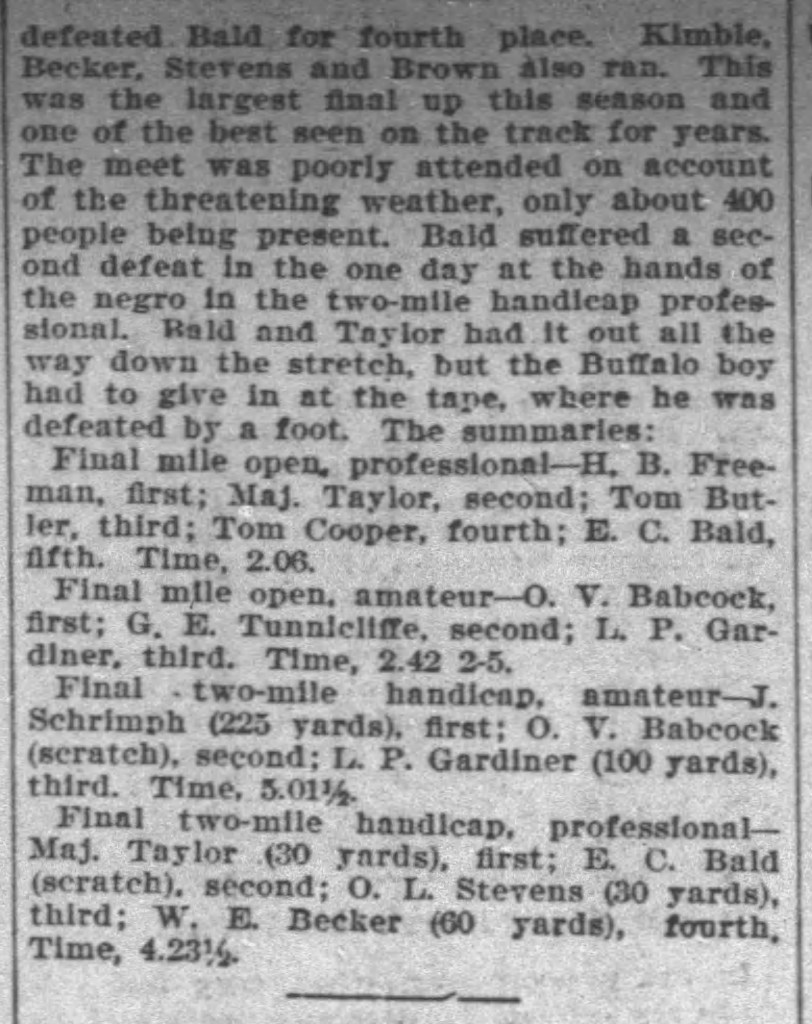
Arthur was mentioned in The Buffalo Enquirer on Wednesday 29th June 1898.
It reads,
Manager Willats of Athletic Field has secured some fine diamonds for prizes to be given in the city championship for amateurs to be run at the National Circuit meet here on July 9th. He expects a large field of starters.
Handicapper McCarthy will probably be here July 4th and will do the handicapping for the July 9th meet while here. He is anxious to see the Buffalo amateurs ride.

Arthur was mentioned in an article called “WILL BE A HOT TIME” which was printed in the Buffalo Courier on Saturday 6th August 1898.
It reads,
WILL BE A HOT TIME,
Plans of the Buffalo Boom Delegates.
All the Delegations from the Central and Western States Are With Us.
"There'll be a hot time in Indianapolis Monday night. It was so decided at the meeting of the delegates of the Associated Cycling Clubs last night. On Monday morning the delegates, uniformed in blue coats and duck trousers, will parade from the Genesee Hotel to the depot and when Indianapolis is reached Monday evening a band will meet them and will lead the march to the Dennison Hotel, which will be the headquarters of the Buffalo, the New York, the Philadelphia and Cleveland delegations. On the way up from the depot sticks of colored light will be carried by the delegates who will march three abreast. The line on the right will carry red, the second line white and the outside have blue.
To make things interesting for the Boston delegates the New York delegation which rules the destination of the American Wheelmen will unite with Buffalo in its efforts to secure the L. A. W. convention for next year.
Philadelphia will send seventy-five delegates to the National meet this year and the party will be in Buffalo Monday evening.
Mr. Baker, who just returned from New York yesterday, says that he has the positive assurance from the Philadelphia aggregation that it can see no city but Buffalo in the fight. Ohio's delegates have already committed themselves to Buffalo, Taxas, Tennessee, Indiana and Illinois, and in fact, all the states, except the eastern section, will route from Buffalo. How Buffalo can lose does not seem evident now.
Last night a representative from one of the large clothing houses measured the delegates for duck trousers.
The association did not intentionally send one of its smallest members to get a rate but a bargain was made to supply trousers at $1.45 per pair. Everything went all right until William Ehmann and Arthur Willats were trotted up to have their measure taken. Ehmann was taxed 55 cents extra because of his long legs and the tailor estimated that it would be worth at least a dollar extra to furnish meterial to make a pair large enough for Mr. Willats. Everything was peacefully settled and measures taken.

Arthur was mentioned in The Buffalo Enquirer on Thursday 8th September 1898.
It reads,
Mrs Rose Juden, 35 years old, started for the poorhouse this morning because she lost her suit against Mrs. John Heinrich of No. 373 Elk Street, in Municipal Court.
She brought the action to recover $29, which she claimed Mrs. Heinrich converted to her own use. She hadn't a cent in her pocket when she went into court.
Attorney Urban C. Bell of the firm of Mackey & Bell, No. 1020 Guaranty Building, volunteered to try her case. Mrs. Jude hoped to win her suit, expecting the $29 to keep her until she could get work.
Last February a race tout named Arthur Willats, who hung around the Manhattan Hotel, at Main and Mohawk streets, a great deal, borrowed $45 from Mrs. Juden. He promised to pay the money back in a short time. He failed to keep his promise and Mrs. Juden went to Detective Ed Conroy and Attorney Albert Lange.
They went to Detective Ed Conroy and Attorney Albert Lange. They went to Judge King and got a warrant for Willats' arrest.
Mrs. Juden appeared in Police Court with her cousin, Mrs. John Heinrich. Willats paid the $45 before the case came to trial and Mrs. Juden withdrew the warrant. According to the story. Mrs. Juden told Judge Hinson in Municipal Court this morning, Mrs. Heinrich grabbed the money from her hand and said : “I’ll take care of this.”
Mrs. Juden possesses a soft, easy-going nature, so she made no very strenuous remonstrance. She says that afternoon, under the supervision of Mrs. Heinrich, she bought about $16 worth of clothes for herself and her young daughter.
daughter. Mrs. Juden claimed in court that the remainder of the $45 was converted by her cousin, Mrs. Heinrich.
Attorney Bell made a strong, sympathetic plea for her.
“If she doesn't get this money, Judge,” said Mr. Bell, “this woman will have to go to the Poorhouse, for she is destitute.”
“I sympathize keenly with the woman” answered Judge Hinson, “but I'm here to administer justice impartially. I deny your motion for an order directing Mrs. Heinrich to pay the money. Mrs. Heinrich's veracity is as unquestioned as your client's, and she swears that every cent of the money was paid back.”
Mrs. Juden broke down and seemed to fall into a stuper when she realized this.
She suffers from epileptic fits. She became nervous and hysterical after Judge Hinson had given his decision. Attorney Bell feared she was going to fall into a fit, so he took her aside and diverted her mind from her lost case.
'*She's got my money, but I couldn't prove it,' said Mrs. Juden, as she left the court room. 'I'll go to the Poorhouse, for I can't get any work and I know I'm getting ill”
Mrs. Juden's right hand was done up in bandages. A week ago she met with a painful accident, a quantity of boiling water having been spilled over her hand.

From the U.S City Directories, we know Arthur was renting and residing at Number 1689 Main Street, Buffalo, Erie, New York, United States of America in 1899.


Main Street was extended over Big Buffalo Creek to Lake Erie ca. 1835 and macadamized during the last years of the 1830s.
Buffalo developer Benjamin Rathbun erected the Webster Block on the east side of Main Street at the southern end of the Downtown survey area in 1835, among his numerous construction projects in the city. During the period 1835-1836, Rathbun erected 99 buildings, including 52 stores, 32 dwellings and a theater. Constructed for Joy & Webster, the Webster Block of four-story brick buildings comprised seventeen stores, wholesale and retail houses dealing in groceries, dry goods, and other commodities. In addition to the stores, moderately priced hotels for immigrants and sailors were constructed in the area and included Huff’s Hotel and Traveler’s Home at the corner of Main and Scott streets.
Located near the present Erie County Convention Center, the first Young Men’s Christian Association (YMCA) in Buffalo was founded along Main Street in April 26, 1852. This facility was only the third in North America and the second in the United States (Montreal and Boston were the first and second sites, respectively.)
Contributing to this growth was the creation of several horse-drawn, steam, and later electric railways that ran through the City of Buffalo. A line operated along Main Street to Ferry Street between 1847 and 1860. The Niagara Streetcar Company laid iron rails for its cars beginning in 1860, although it is not known whether the company had the use of Main Street. The Buffalo Street Railway Company operated a horse-drawn service along Main Street between Genesee Street and the docks at Buffalo Creek beginning in July 1860. The line was extended to Delaware Park by 1879. By 1884 more than 40 miles of track were in use for streetcars, employing 350 men and 730 horses to operate 120 cars. The International Railway Company, a local street railway, was the first electric railway in the city in November 1896. The advent of the electric streetcar and the laying of miles of track helped not only the ability of people to circulate through the city, but provided an impetus to centralize the business/retail, entertainment and other commercial interests of Buffalo along Main Street near these lines.
By 1868 commercial interests dominated the Main Street streetscape and included a variety of establishments: milliners, grocers, a cutlery store, hardware stores, banks, a plumber, haberdasheries, dry goods stores, a confectioner, a furniture store, a tobacconist, a liquor store, a botanical drug store, and a purveyor of chinaware. Most of these commercial interests were located in brick or brick and frame buildings ranging from three to four stories. Areas a block or two from Main Street also housed a variety of enterprises, including commercial and industrial ventures, mixed with residences. East of Main Street, for example, a birdcage factory was documented at 510 Washington Street and Washington Savings Bank was recorded at 437-439 Washington Street. A coffin factory, bakery, a boot shop and a book binder were located on the same block. The Hersee Furniture Factory was first recorded on the 1868 map at the foot of East Mohawk Street, on the east side of Ellicott Street at Hersee Alley. A brewery also was identified at 20 Broadway and a saloon was located next door. The Machine Shop and Brass Works was first recorded in 1868 at 46-48 Broadway and a dyers shop was located at 50 Broadway. The cast-iron front German Insurance Building was erected on Lafayette Square and Main Street in 1875.
After the Civil War, the establishments along lower Main Street as well as those in proximity were a mix of small stores on the first floors with factories, warehouses and apartments on the upper stories. In 1866, George Moore & Son operated a dairy store at 65 Main Street; Bush & Howard ran a leather dealership at 91 Main Street; Johnson & Klein had a dealership of general produce at 93 Main Street; the Union Stove Works, under the proprietorship of George B. Bull & Co., operated a warehouse of home furnishings at 95 Main Street. In addition, F.S. Pease sold paint and oil from his establishment at 61-63 Main Street; F. Colligon ran the Eagle Brass Foundry from the corner of Perry and Washington streets; and John T. Noye operated the Buffalo Mill Furnishing at the corner of Scott and Washington streets.
Beginning in the late nineteenth century, homes in the city’s central business district were replaced by buildings housing commercial, banking, and insurance operations as well as light industrial buildings. At the time, Main Street in the 500- to 700-block area (north of Lafayette Square) was densely populated with both commercial buildings and residences. In the 1880s, the Brunswicke-Balke-Collender Company manufactured billiard tables at its 597 Main Street factory.
In 1893, Seymour H. Knox opened a store at 519 Main Street after his original store at 409 Main Street was destroyed by fire. Less than two years later, Knox relocated his five-and- dime to 395 Main Street. Later, he later merged his store with that of his cousin, who owned Woolworth’s.
This expanse of Main Street is treated as the Theater District Historic Preservation District. The Theatre Historic District is centered on the 600 and 700 blocks of Main Street between Goodell and Chippewa streets and represents the height of Buffalo’s commercial and entertainment pre-eminence between the 1880s and 1940s, and includes The Courier Express Building, the former Greyhound bus terminal, Shea’s Buffalo Theater, and Market Arcade. The area was primarily residential until the middle of the nineteenth century, and became increasingly commercial during the century as commercial and manufacturing operations relocated from those areas in proximity to the waterfront and residential areas moved farther to the north and east. During the late nineteenth century and early twentieth century this area was home to a prominent jewelry store in the Dickinson Building, the Wurlitzer store in a former carriage factory, a patent medicine factory and convalescent hospital (The Pierce Building at 651-661 Main Street), and the former Pierce Arrow Motor Car Company showroom (in the Vernor Building), as well as numerous theaters, such as Shea’s Buffalo Theater, a former movie house.
As the downtown area drew business and retail enterprises, a boom in the construction of office buildings ensued, transforming the character of Main Street from a frame-and-brick, commercial-residential mix to large, steel-and-stone, corporate offices and businesses. Two structures erected in 1896 mark the beginning of the transition: The Guaranty Building (a National Historic Landmark), one of the first modern skyscrapers designed by Louis Sullivan, located on Church Street in Buffalo; and the Ellicott Square Building, at the time the world’s largest office building covering a block comprising Main, Swan, Washington and South Division streets (designed by Daniel Burnham). In 1904 Frank Lloyd Wright completed the Larkin Administrative Building, the headquarters for the Larkin Soap Company on Seneca Street. The Market Arcade building, designed by E.B. Green and William Wicks, was erected in 1892 and the Brisbane Building on Main Street had been completed in 1895.
The 500-block of Main Street and the three-story commercial buildings on East Genesee Street represent the small-scale vernacular commercial buildings that once comprised much of the city’s central business district. This gradual transformation was replicated for properties along Washington, Ellicott and Oak streets, and land use shifted from scattered, small-scale commercial buildings and residences to a compressed area of large, auxiliary commercial loft buildings and light industrial buildings. Additions to the city-scape included the Buffalo Savings Bank at 545 Main Street in 1901; the Lafayette Hotel on Lafayette Square in 1904; the Hippodrome Theatre on Main and Huron streets in 1904; the Statler Hotel across from the Ellicott Square Building in 1906; the Sidway Building at 775 Main Street in 1907; and the General Electric Tower (formerly the Niagara Mohawk Building) on Washington Street in 1912. In the early twentieth century, warehouses were constructed along Washington Street to support the retail industry, whereas light industrial enterprises emerged on Ellicott Street.
During the mid-to late nineteenth century, the area west of Main Street shared a similar building stock of mix of vernacular commercial buildings and dwellings with that on the east side. However, buildings constructed on this side in the early twentieth century were distinguished from those of the east by their location and use. This section of the city became the retail shopping district as a result of its proximity to the offices of the financial and government districts of the city. Large department stores, such as Hens and Kelly, L.L. Berger, Edward’s, and Woolworth’s replaced smaller commercial buildings on the west side of Main Street. These multi-storied retail houses extended their operations with either additional frontage or ancillary storage warehouses on Pearl Street. During the first half of the twentieth century, businesses associated with several of Buffalo’s major industries occupied lots between Broadway and Genesee Street east of Main Street.
In the early twentieth century, while parts of Main Street attracted corporate skycrapers and business and banking construction, lower Main Street area saw increased development as part of the growing influence of the railroad. The Lehigh Valley Railroad constructed a railroad yard and a station north of the Erie Canal east of Main Street.
At the beginning of the twentieth century, areas south of Exchange Street and the Terrace were solidly in rails as both the Lehigh Valley Railroad and the New York Central Railroad controlled extensive yards with freight and passenger operations. In 1917, the Lehigh Valley Railroad opened its passenger terminal on what is now the Donovan Block. Industries within the Cobblestone District included Case & Son Radiator Factory, at the site of the former Jewett molding shop at Elk and Mississippi streets; Wegner Machine Company at Perry and Liberty streets; the DL&W Railroad freight house between Liberty and Columbia streets; Schoellkopf & Company tannery north of Perry Street between Mississippi and Liberty streets.
The DL&W had laid tracks along the river from Main Street to its coal yards north of Erie Street and the New York Central had a shipping facility near the Coit Slip. During this period, the freight-carrying capacity of Buffalo’s various railroads had eclipsed that of the Erie Canal, and areas along the canal and waterfront declined and became a warren of decrepit buildings, and towering grain elevators.
In addition to the growth of the railroads, the improvements in grain-elevator construction methods, the advent of electric power, and the relocation of Lackawanna Steel to the Lake Erie shore, south of the Buffalo city limits in what is now the City of Lackawanna, propelled Buffalo to increased industrial growth and manufacturing expansion after World War I.
By this time, the commercial areas along the canal had been transformed into residential areas, with tenements built to house Italians and other immigrants. In 1926, the Commercial Slip, the connection between Lake Erie and the Erie Canal and the linchpin of Buffalo’s nineteenth-century economic success, was filled. In addition, between 1927 and 1937 the Erie Canal was gradually filled, usually with garbage and debris, although parts of it were still open north of Porter Avenue in the 1950s.
Although flour had been milled in Buffalo since 1826, flour milling expanded dramatically during the first decades of the twentieth century, rising from a few thousand barrels at the beginning of the century to more than 12 million barrels of flour and 480,000 tons of wheat in 1930 (1 barrel of flour equals 4.7 bushels of wheat). In 1923, 270 million bushels of grain passed through the waterfront area.
By the end of the 1920s, 39 variously sized grain elevators were situated along the Buffalo River and around the harbor, including those operated by Washburn-Crosby (now General Mills), Pillsbury, George Urban Milling Co., and Hecker-Jones-Jewell Milling Co., among others. In addition to milling operations, cereal companies were also located in the city, including Hecker H-O Company, the Mapl-Flake Company, and the Shredded Wheat Company. Near South Park Avenue (formerly Elk Street), east of Michigan Avenue, the H-O Oats mill complex opened in 1893, with the main mill in operation by 1907. The facility expanded with buildings erected in 1912, 1928, and 1931, but was demolished in 2006 for the proposed Seneca Buffalo Creek casino project (which was recently completed).
In addition to grain, in 1928, more than 750,000 tons of anthracite coal from Pennsylvania arrived in Buffalo by rail for transshipment westward on emptied grain ships, which also carried iron and steel products and automobiles. The opening of a deeper and wider Welland Ship Canal in 1932 began to erode Buffalo’s leadership in the shipment of grain.
In the 1920s in general, Buffalo’s vibrant industrial economy attracted other manufacturing concerns, such as the Curtiss-Wright Aeroplane Company (which employed more than 2,000 people in the 1920s), the burgeoning automotive industry employed more than 15,000 workers, various machine shops and foundries employed 13,000, meat-packing industries employed 3,000 workers as did the soap-making industries, but many of these operations were not located downtown near the waterfront.
The city had a population of 506,775 in 1920. During the 1920s, prominent buildings constructed along Main street included the Liberty Bank Building in 1925; the NRHP- listed Shea’s Buffalo Center for the Performing Arts in 1926; the Rand Building in 1929; and the Courier-Express Building at 785 Main Street in 1930.
At the beginning of 1930s, the waterfront area on both sides of Main Street south of Exchange Street was considered a slum, especially after the New York Central Railroad relocated its passenger terminal farther east. With the station closed, businesses catering to the station’s clientele fell on hard times. The War Memorial Auditorium was erected along the west side of Main Street at the former confluence on the Erie Canal and the Commercial Slip between 1938 and 1940.
The economic expansion during the early twentieth century was felt all along Main Street and in the northern portion of the Downtown survey area. For example, M. Wile & Company, retailer of ready-made, mass-produced men’s clothing, erected a building on the southeast corner of Ellicott and Goodell streets in 1924. The four-story structure was designed by Buffalo architectural firm Esenwein & Johnson and “introduced state-of-the-art industrial architecture into a traditionally German-immigrant community where it proudly manifested the rise to success of its German-born owner”. The factory was erected on the former site of the College Creche, which was the second child day-care center in Buffalo, and occupied the home of Solomon Scheu, a prominent Buffalo jurist of German descent. “At the time of its construction by a prominent member of this community [Buffalo’s German-American] (which made up forty percent of the city’s population), the M. Wile & Company Factory building ranked as a landmark of the German section of Buffalo”. By 1920, the firm employed more than 250 workers. It remained in operation until 1999.
In addition, Trico (Tri-Continental Products, later Trico Products Corp.) constructed a manufacturing plant along Ellicott and Goodell streets over a period of about thirty years, with modifications continuing through their occupancy. Trico was founded by John Oishei in 1917. Oishei and inventor John Jepson developed and manufactured the first automotive windshield- wiper blades, and ca. 1920 moved their factory into the former Weyand brewery building on Ellicott Street. The advent of Prohibition in 1920 did irrevocably damage to the success of Buffalo’s brewing industry. Christian Weyand, a brewer since 1868, had expanded onto Ellicott Street from Main Street about 1890; the brewery closed in 1920. The Trico plant on Ellicott Street was an accretion of buildings, which by 1937 occupied the entire block bordered by Goodell Street, Ellicott Street, Burton Place, and Washington Street. The company originally employed 35 workers and it continued success enabled it to employ more than 4,600 by 1950 (Ross and Kowsky 2000b). The plant remained in operation until 1998.
While the Belt Line and the interurbans liberated many workers from residing near their places of employment and provided for the geographical expansion of businesses within the city, Main Street still served to divide the East Side from the West Side. So much so that by the end of the nineteenth century, the area east of Main Street was perceived as “foreign, exotic, mysterious, and dangerous”; the place where immigrants and foreigners—Poles, Germans, Irish and Italians—as well as black and Eastern European Jews lived. Later, as German and Polish workers followed industry and relocated from the East Side to Black Rock, among other places, “William [Street] was lined with Jewish businesses: bakeries, butcher shops, barber shops, bicycle shops, dry goods stores, clothing stores, tailors, and shoe repair shops (until forced out by Italian competition, shoe-making was quite a Jewish business). Almost a dozen synagogues stood in the area by 1920”. Buffalo’s small black community remained clustered around the Michigan Avenue Baptist Church and the AME Church and school on Vine Alley. During World War I, however, black immigration to Buffalo would grow sharply.
From 1880 to 1920 Buffalo’s population increased from 155,134 to 506,775. During this period, its black population rose from 857 to 4,511, and to approximately 9,000 in 1925. Much like European immigrants who had settled in areas where others who shared their heritage and language lived, black immigrants created a distinct “Negro” district on the East Side after 1900. “The core of this area was the established black community in the lower East Side which by the early twentieth century included William Street, South Division, Michigan Avenue, and Broadway”. Paralleling the German East Side during the late nineteenth century, a plethora of black-owned businesses, including hotels, nightclubs, funeral parlors, cleaners, drug stores, restaurants, candy stores, saloons, and a theater, developed to cater to the area’s residents.
During the twentieth century, the residential situation became increasingly segregated. In 1915, blacks lived in 21 of Buffalo’s 27 wards, although they were more concentrated in Wards 6 and 7, near downtown. By the end of the 1930s “African Americans increasingly were restricted to two areas of settlement within the city, the Ellicott and Masten Park districts, both of which had been recently abandoned by various immigrant groups”. The city’s black population continued to increase during the 1940s, drawn to employment opportunities at Buffalo’s numerous industrial operations, rising from 18,000 to 24,000 between 1940 and 1945, and to more than 37,000 in 1950. Most of this population increase was located east of Main Street.
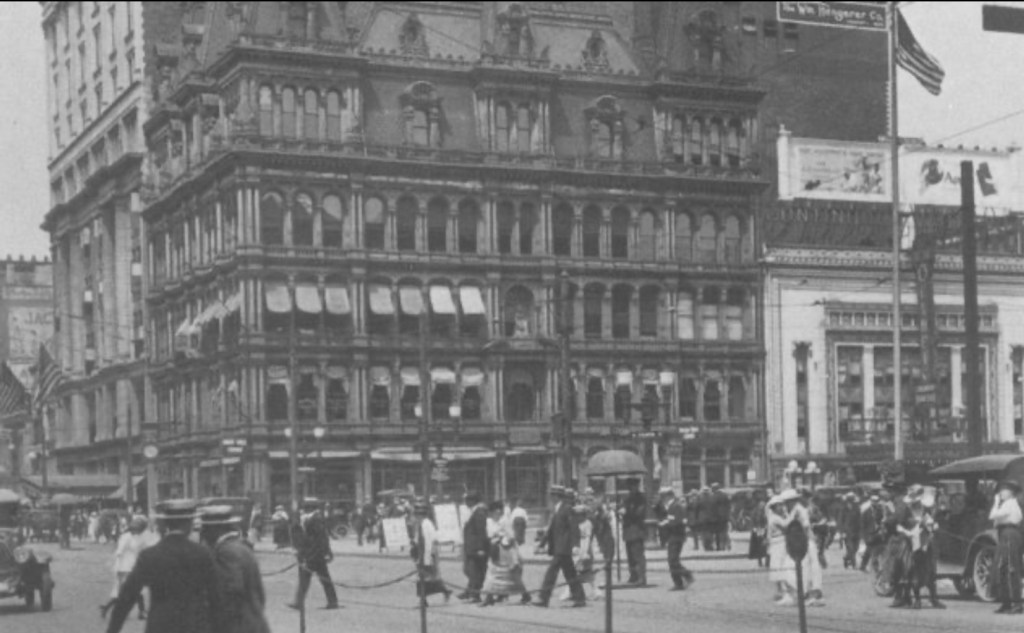
Arthur was mentioned in the Buffalo Courier Express, on Friday 20th January 1899.
It reads,
Manager Arthur C. Willats of the Buffalo Athletic Field is in town and President Charles A. Johnson of the Buffalo Athletic Field Company paid a brief visit to the city recently, Both men refrained from indulging in public comment on the subject of Mr. Johnson's election to the presidency of the National Cycling Association, the body of track-owners and others interested in cycle racing which proposes to relieve the L.A.W. of control of the sports. While in the city, Mr. Johnson had a talk with Walt W. Wilson, who is prominently identified with the movement.
"What did he say?" a reporter for The Express asked Mr. Wilson yesterday.
“I am not at liberty to state, just at present,”he replied, "but I will say that there will be some developments of interest to Buffalonians before Long.
I might add that I was not far wrong when I told you at the time of the election of Mr. Johnson that he was in sympathy with the movement and would accept the office.
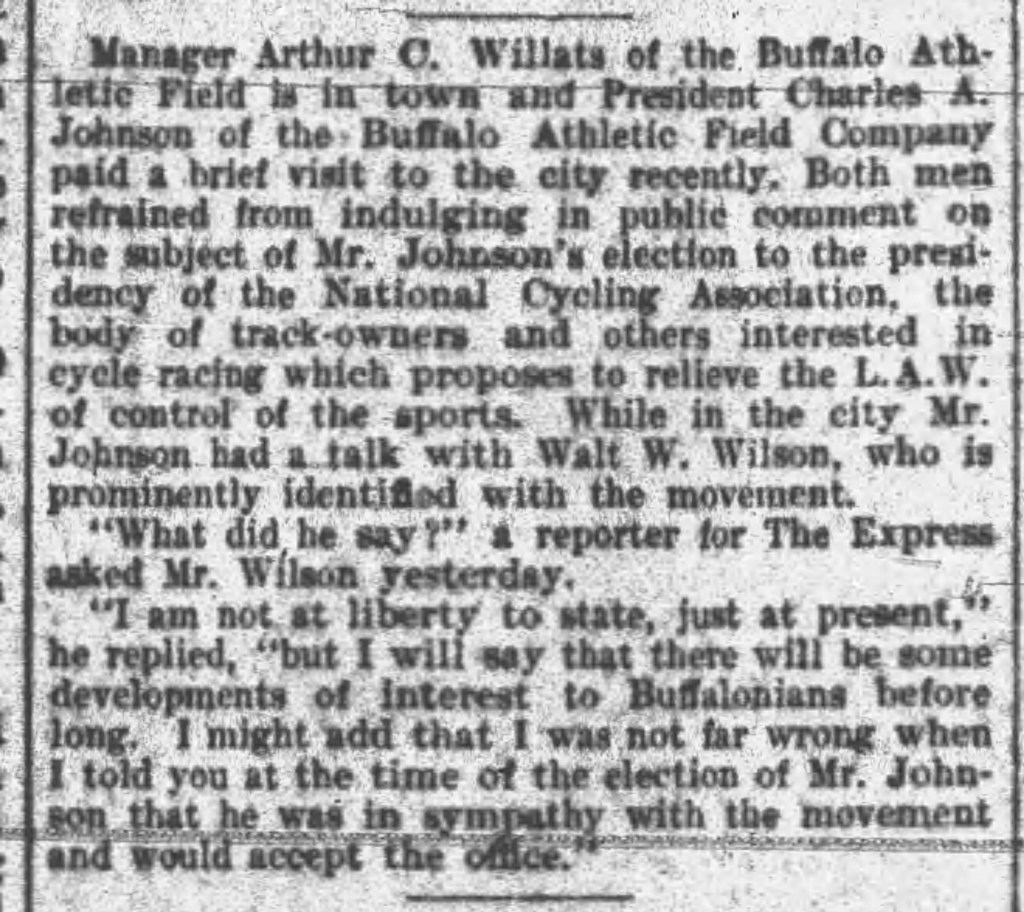
Arthur was mentioned in an article called “Mr Wilson Explains Some Cycle-race Statements.” which was printed in The Buffalo Courier Express on Wednesday 25th January 1899.
The part of the articlethat Arthur was mentioned reads as follows,
CURRENT SPORT CHAT
Mr. Wilson Explains Some
Cycle-race Statements.
ABOUTTERRITORIAL RIGHTS.
MANAGER WILLATS OF THE BUFFALO ATHLETIC FIELD IS NON-COMMITTAL DUTCH NEAL RECALLED-KID M'COY ON RUSHING - SOME MATTERS OF NOTE.
Arthur C. Willats, manager for the Buffalo Athletic Field, who has been in town for several days, was asked by the reporter yesterday what stand Mr. Johnson had taken on the revolt from the league, the Buffalo Athletic Field president not having come out with a positive statement of his position.
Mr. Wiltats's reply was non-committal.
"As a matter of fact." said a well-known wheelman to the reporter, you will find that Mr. Johnson will not make known his position until after the National Assembly of the L.A.W. at. Previdence next month. If the league drops racing you will find Mr. Johnson out firmly as president of the new association, while if the the league decides to continue in control of cycle racing you will find Mr. Johnson with the league. As the matter stands the new movement has unconsciously given him a fine opportunity to sit on the fence and he is taking advantage of the position. So far he has not committed himself in either direction, publicly."

Arthur was mentioned in an article called “BUFFALO WON'T BE REPRESENTED”, which was printed in The Buffalo Courier, on Tuesday 7th February 1899.
It reads as follows,
BUFFALO WON'T BE REPRESENTED,
Local L. A. W. Officials Will Stay Home.
PROVIDENCE MEETING.
Mr. Baker Gives Wise Reasons for Not Attending Assembly — Trip
Not Worth the Price.
Buffalo will not be represented at the meeting of the L.A.W. at Providence tomorrow.
William B. Baker intended to go until a few days ago but has changed his mind. The delegates will be obliged to pay their own expenses to the assembly this year, and Mr. Baker says he cannot see how he can do Buffalo wheelmen or any other wheelmen $50 worth of good by attending the meeting tomorrow.
As there is no money in the L.A.W. treasury the delegates will be obliged to defray their own expenses. In former years the funds of the League were always fat enough to stand the expense of sending delegates to the national assembly, but because of the insurrection on the part of the racing men, the coffers are empty.
As many of the delegates have to go a long way to attend the assembly they cannot afford to lose the time and pay their own expenses, and the meeting this year will be slim. It is not the matter of a few dollars with Mr. Baker, but considering the condition of affairs he does not consider his vote on the racing question worth the cost.
It is possible that Arthur Willars, manager of Athletic Fielt will attend.
He has just returned from an extended trip through California with G. A, Johnson, and has not had time to give the matter much consideration.
If he did go it would only be as a visitor for he has no offical connection with
with the L.A.W.
Mr. Willats says he does not think he should be too quick to pull away from the L.A.W. Athletic Field is the only track in New York that is free from suspension.
Mr. Willats says he is just waiting for the Pan-American boom to show its force before he makes up his programme for the coming season.
Mr. Stuart Kelly, who is also one of the delegates told the sporting editor of The Courier last night that he had sent a proxy to the meeting with instructions to cast his vote for the retention br the L. A. W. of the control of racing.

Arthur was mentioned in an article called “ATHLETIC FIELD.” which was printed in The Buffalo Commercial on Monday 5th February 1900. It reads,
ATHLETIC FIELD.
Arthur Willats is Again in Control of the Management - Outdoor Sports to be Seen There.
Arthur C. Willats, representative of Charles A. Johnson, proprietor of Buttalo Athletic Field, has again assumed the management of that park, the Olympic Games Company having relinquishes control there-of. Mr. Willats will not define Proprietor Johnson's intentions as the latter is In Mexico, but he predicts that bicycle races, baseball, football and all other outdoor sports will receive suitable attention. The unsightly "Shoot the Chutes" apparatus will be moved, and the pond will be used for water sports.
The Fleld is splendidly located, and Manager Willats thinks that some big amusement company will get it for Pan-American year.
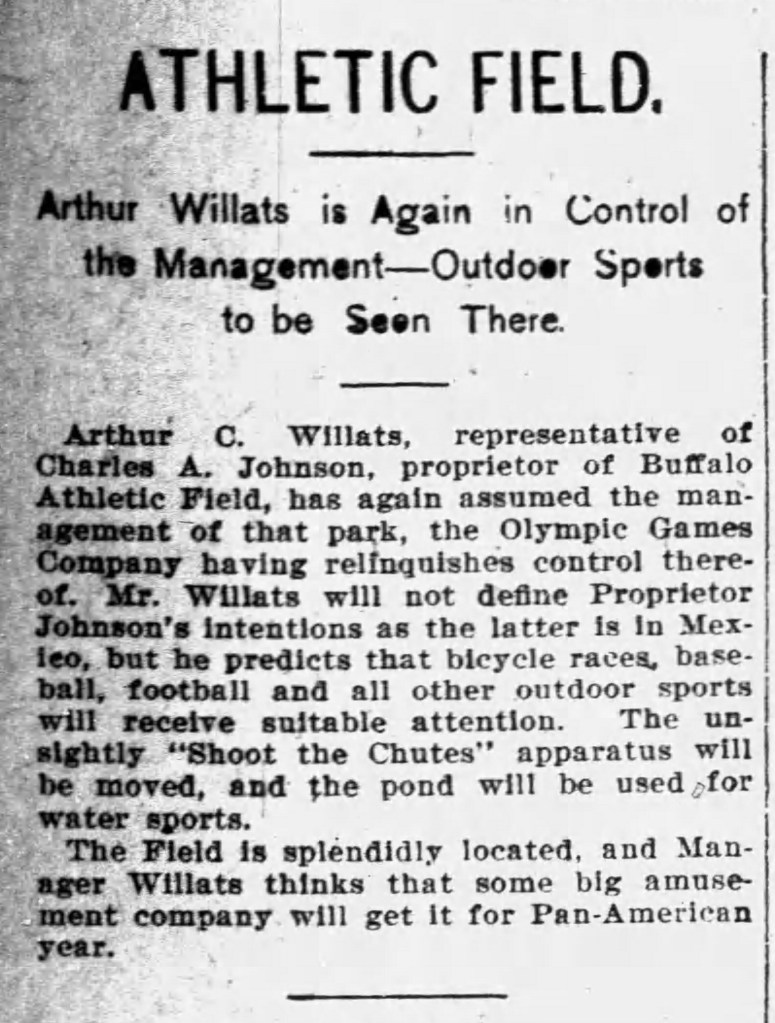
Arthur was mentioned in an article called “Option Given Up.” which was printed in the Buffalo Courier Express, on Monday 5th February 1900.
It reads,
OPTION GIVEN UP.
Olympian Games Company Surrenders Field.
LACK OF PUBLIC INTEREST
MANAGER WILLATS AGAIN ABBUMES CHARGE OF BUFFALO'S FAMOUS BICYCLE TRACK - PROGRESSIVE BUSINESS-MEN OP-THE CITY DISCOURAGED WITH REWARD FOR IMPROVEMENTS WILL MADE IN FIELD'S APPEARANCE.
As the time for the renewing of the lesse of the Buffalo Athletic Field by the
Olympian Games Company of Buffalo has come and gone the local bicycling world has been not a little attached by repeated rumour to the effect that, falling the renewal of the lense the quarter-mile cement bicycle track would be destroyed and the field cut up for building purposes.
It will be a matter of general relief to learn that, while the lease will not be renewed, the field will continue, at least until after Pan-American year, as a sporting resort, the Intention of the owners being to maintain it practically intact during that period.
In order to ascertain, for the benefit of the public, just how matters stood in regards to the relations of the Buttalo Athletic Field Company and the Olymptan Games company representative, of The Express called upon Myron O Dunny, president of the latter organisation, to insure his views on the subject. Mr. Dunny said:
“We have concluded not to take advantage of our option of the Field and have so notifed Mr, Johnson. The lack of public Interest in the sport led us to take this step. It was no fault of the Field and certainly cannot be laid to the Olympian Games, Company, which strove to amuse and please the public and gave the best meets possible in the bicycle line. I understand that all lines of sport suffered last year: baseball, football, boxing and other classes of sport were poorly attended and we figured that it would be better to drop it now than go through another year of poor support.
All of the stockholders are business-men and went into the thing more to boom
the sport than for the profits to be made."
A visit to. the office of the Buttalo Athletic Field Company found Its representative, Arthur C. Willats, and to him the question of the track's future was put:
Manager Willats in substance replied:
"As our president, Mr. Johnson, Is In New Mexico at the present time It is hard to get word to or from him. I do not know what he will say about the Olympian Games Company giving up its option, but I think that he will be more pleased than otherwise for the reason that several good offers have been received for the Field by showmen who realize its close proximity to the Pan-American site. You can state that improvements will be made In the grounds as quickly as possible.
The unsightly chutes will be removed and the lake will be arranged for water sports. We are in hopes that Assemblyman Bradley will succeed in passing his baseball amendment, for in that case we will lay out a diamond, with the hope that some of the amateur leagues will see the superier advantages of the place and engage it for games.
"While I am quite posttive that Mr. Johnson will not promote any games on his own account I know that he will, if the Field is not leased outright, to others, be pleased to rent the Field to the bicycle clubs for any enterprise that they may see fit to undertake on their own responsibility.
This season we will cater to all kinda of sport, especially to societtes that wish a place where they can hold games in connection with their outings, for as soon as the ground and weather will permit we shall put down a tanbark track for a 100-yard dash, upright for pole vaulting, and other athletic convenience. Of course, bicycle races will be the main feature of the season's sport, that is what the track was built for and that is the main reason that it secured membership In the N.C.A., being one of the first tracks to lend its aid to the bicycle-racing organisation.
*Now, while It would be unjust and unwise for me to censure the Olympian Games Company for thelr methods last season, still I will take the liberty, to say that I think if they had entered to different classes of attractions they would have been more successful and not so ready to give up their option during what promised to be the two best yeur of the "tracks existence "
The conclusion drawn from Mr. Willats' remarks was that the Field would not be leased this year, but would be run by its owners.

Arthur was mentioned in an article called “Athletic Field.” which was printed in The Buffalo News, on Monday 5th February 1900.
It reads,
Athletic Field.
The Olympian Games Company has given up its option on Athletic Field, and it looks now as if meets run there this summer will have to be under the auspices of the different athlete organizations unless President Johnson of Athletic Field does some sport promoting on his own account. The Olympian Games Company gave as their reason for abandoning the field that not enough popular interest in sports was taken last year to pay for leasing the property.
Arthur C. Willats, Mr. Johnson's representative in this city, said yesterday that Improvements would be made at the field for this season's sport, whether the, field wes leased or not. The chutes are to be removed, and the lake will be made suitable for water sports, If the Bradley bill allowing Sunday baseball becomes a law, a diamond will be laid out and the field rented to different clubs.
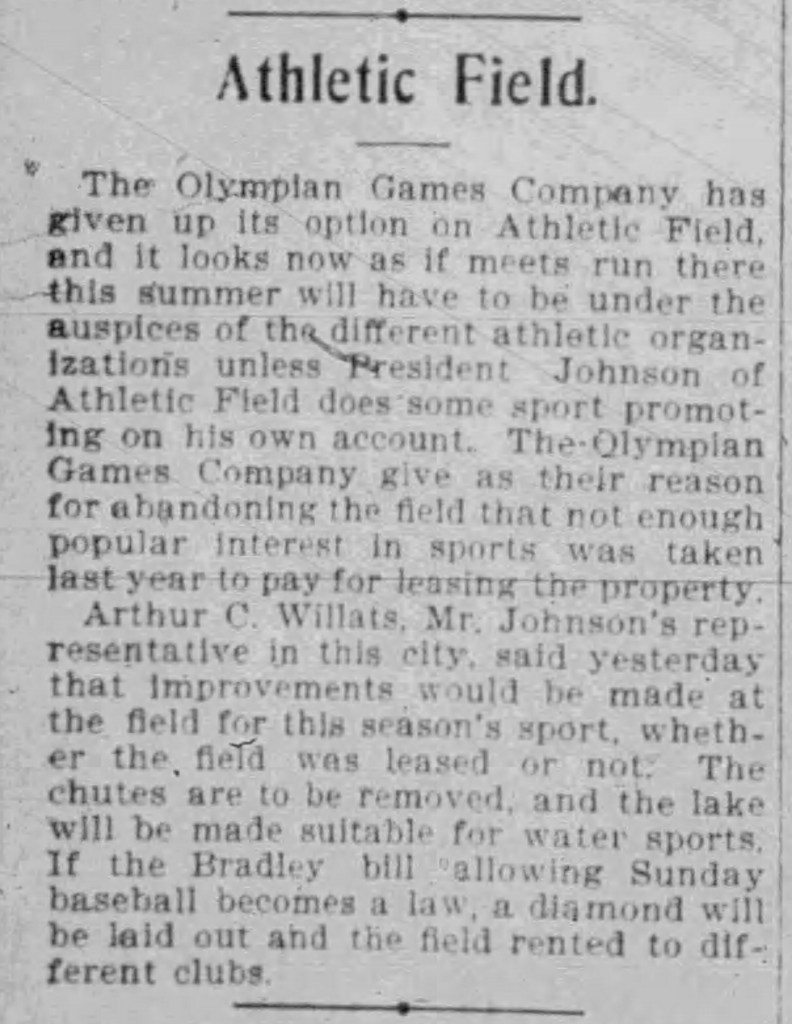
Arthur was interviewed for an article printed in The Buffalo Courier on Saturday 17th March 1900.
It reads,
THE ATHLETIC FIELD.
Speculations as to the Policy Which Will Govern It This Season.
The disposition of the Buffalo Athletic Field is causing some interrogations on the part of many citizens who are desirous of knowing just what is what.
The Olympian Games Company which managed the field last season, fore-swore charge of it early in the season and since that time its finish has been in doubt.
Charles A. Johnson, owner of the field is in New Mexico where he has interests and the probability of his returning to Buffalo this year is scouted.
Arthur C. Willats, who has been identifled with the Field since it was built, is in charge of it now.
"There has been nothing definitely decided as yet," said Mr. Willats yesterday. "I am expecting to hear from President Johnson as to his plans for the season and when I do hear from him there will be something definite to give out.”
"Do you belleve that the Fleld Company will promote any meets this season,” he was asked.
“No I do not, “ was the reply. “There will be the usual Decoration Day meet given by some club and that will open the season, but I do not think that there will be any meets run under
the season, but I do not think that there will be any meets run under our direction."
It was rumored some time ago that the unsightly "shoot the chutes" would be removed, but nothing definite has been decided as yet.
It is likely, that there will be several big outings held during the summer season at Athletic Field.

Arthur was named in an article called, “BUFFALO TO HAVE NATIONAL CIRCUIT. Manager Willats Makes Application.” which was printed in The Buffalo Courier, on Wednesday 18th April 1900.
It reads,
BUFFALO TO HAVE NATIONAL CIRCUIT.
Manager Willats Makes Application.
BOARD OF CONTROL.
Dictators of the Destinies of the N. C. A. Due Here This Week.
Buffalo is to have a National Cireuit Date, though for a time matters assumed a somewhat dubious look. Buffalo without all of the big cycle racers here would surely be a strange community.
N. E. Sturgeon, chairman of District “B” of the N. C. S. has been striving for some time to induce some person, persons, or some club to make an application at the next meeting of the Board of Control, which will be held here next Saturday, for the date, but until yesterday there was a decided hesitancy on the part of any one to assume the responsibility.
Arthur C. Willats, manager of the Buffalo Athletic Field, and for his Company, yesterday made an application and thus local cycle enthusiasts are assured of one good day of cycle racing for the ensuing season, a day when all the stars of the cycle firmament are to gather in Buffalo and strive for gold and fame on the athletic field track.
The big fellows of the path are training hard at Fountain Ferry track. Bald, McFarland, Stevens, Maya, Kimble, Cooper and Kiser and when they branch out for the season they will be in the very best possible condition. The climate at Fountain Ferry has been most delightful and the men who are doing their spring work outs at this place have all along expressed great delight at their good fortune in getting the perfect weather.

36-year-old, Arthur, his wife Josephine and their children Beatrice and Richard were residing at, Number 1689 Main Street, Buffalo Ward 17, Buffalo, Erie, New York, USA, on the 1st June 1900, when the 1900 United States Federal Census was completed. It states that Arthur and his parents were born in England. That he immigrated to America in 1882 and he has been in America for 18 years but was not nationalised. It also shows that Arthur was a theatrical performer. That he has not been unemployed, that he can read, write and speck English. It also shows that Arthur was renting a house. Lillie Hart was boarding with them and William Hankins was a lodger in their abode.
| Name | Arthur C Willat[Arthur C Willats] |
|---|---|
| Age | 36 |
| Birth Date | Jul 1863 |
| Birthplace | England |
| Home in 1900 | Buffalo Ward 17, Erie, New York |
| Ward of City | 17 |
| Street | Main Street |
| House Number | 1689 |
| Sheet Number | 1 |
| Number of Dwelling in Order of Visitation | 5 |
| Family Number | 7 |
| Race | White |
| Gender | Male |
| Immigration Year | 1882 |
| Relation to Head of House | Head |
| Marital Status | Married |
| Spouse’s Name | Josephine Willats |
| Marriage Year | 1886 |
| Years Married | 14 |
| Father’s Birthplace | England |
| Mother’s Birthplace | England |
| Years in US | 18 |
| Naturalization | Naturalized |
| Occupation | Heatrieal Heheyer (theatrical performer) |
| Months Not Employed | 0 |
| Can Read | Yes |
| Can Write | Yes |
| Can Speak English | Yes |
| House Owned or Rented | Rent |
| Farm or House | H |

Arthur was mentioned in an article called, “CYCLING SITUATION IS VERY BRIGHT.”, which was printed in “The Buffalo Courier”, on Wednesday 6th June 1900.
It reads,
CYCLING SITUATION IS VERY BRIGHT.
BUFFALO RIDERS WILL COMPETE IN THE NEWARK RACES THIS WEEK — TO GUARD AGAINST ACCIDENT.,
Locally there is a great outlook for the success of cycle racing this season.
There are going to be several meets conducted before the season closes and the Buffalo boys should clean up quite a bunch of prizes during the season.
Zurbrick, Bardgett, Denny, Dahike and several of the fast amateurs who have been working out at the Buffalo Athletic Field will this week go to Newark, this state, where on Saturday there be a big race meet held and the local pedal pushers are expectant of “potting” a few prizes.
“Majah” Taylor wants to ride in Buffalo and his manager R. W. Ellingham has written to manager Arthur C. Willats of the Buffalo Athletic Field asking a race with either Tom Cooper or Frank Kraemer. If a match cannot be arranged the Ethiopian will surely ride at the National Circuit meet, which is to be held here on August 11th.
Eddie Bald did not ride yesterday: instead he took his trainer, Teddie Davis, their wheels and some baggage and hiked over to Hamilton, where the bangtails now are. This jaunt is to "show Davis the horses." Eddie's friends are somewhat disappointed at this turn in his affairs.
There will be no hitch in the motor cycle race, to be held in conjunction with the Rambler's meet on the night of June 14th, because Mr. Willats has made arrangements for another motor machine, to be substituted in the event one of the two now here going wrong.

Arthur was mentioned in an article called, “ATHLETIC FIELD MAY BE FORSAKEN” which was printed in “The Buffalo Courier” on Sunday 9th September 1900.
It reads,
ATHLETIC FIELD MAY BE FORSAKEN
STOCKHOLDERS ARE GOING TO STOP THE RUNNING GAME.
There is a possibility that Buffalo's one redeeming feature in the world of sport may soon be but a memory, the announcement was made yesterday by Manager Arthur C. Willats of the Buffalo Athletic Field that his company were going to dispose of their holdings at auction on September 27th, having tired of it.
It is hard to prediet what will happen if the field should be sold. Containing as it does the quarter mile cement bicycle track, accredited with being one of the best in America, and a track upon which more world's records have been made than on any other track in the land. Also having one of the best inside fields in the land.
If it should come to pass that the field is to be cut up into building lots it would not bespeak many good words for the sportsmanlike quality of Buffalonians. Many exciting struggles have taken place within the enclosure, football contests and struggles awheel.
Bald, Cooper, Michael, Duer and others have made records on its track and the hardest fought football game that the Cornell and Williams elevens ever played took place on this campus. The outcome of the determination to sell will be watched with interest by all true sportsmen here.
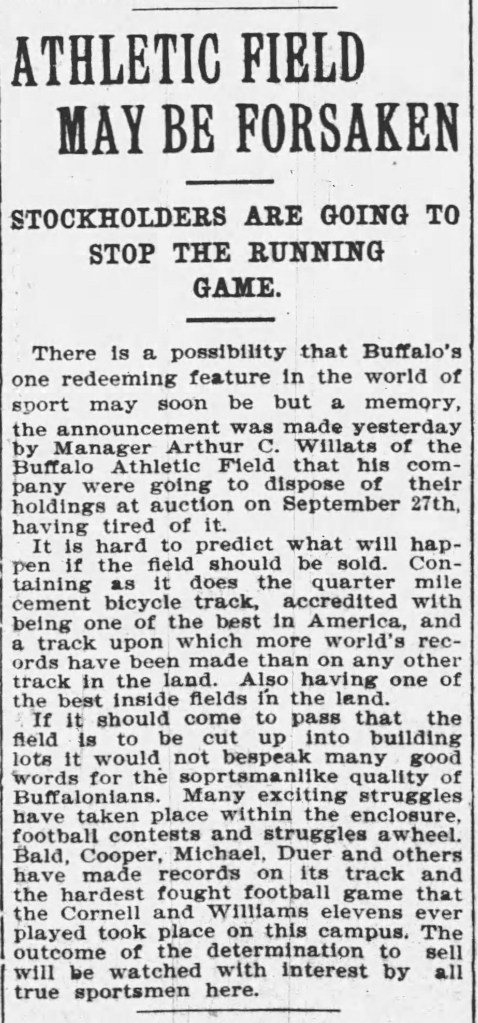
Arthur was mentioned in an article printed in “The Buffalo Courier”, on Friday 21st September 1900.
It reads,
MANAGER WILLATS ANNOUNCES A GOOD CARD FOR OPENING OF SEASON.
Manager Arthur C. Willats of the Buffalo Athletic Field will endeavour to give the local football season an auspicious opening, as he has secured the teams from the Masten Park High School and the Central High School to play on September 29th, one week from tomorrow, and a good game will surely result, as both teams are in daily practice, and they should round to by that time.
As an additional attraction, Johnny Nelson, the middle distance champion and Ray Duer, Buffalo's representative in the paid money division, will engage in an hour contest at the field, and it will be paced by motor tandems.
Popular prices are to prevail and a large crowd should be attracted.

Arthur was named in an article called, “ATHLETIC FIELD SOLD AT AUCTION.” which was printed in, The Buffalo Enquirer, on Thursday 27th September 1900.
It reads,
GREATER BUFFALO.
ATHLETIC FIELD SOLD AT AUCTION.
Buffalo Athletic Field, with all of its stands and buildings, was this morning sold to J. P. King of Toronto. The consideration was $82,000. Arthur W. Hickman and Robert Donaldson of the Erie County Savings Bank also bid on the property, but Mr. King was successful.
It is probable that the property will eventually be cut up and sold, but for the time being, it will be allowed to remain as it is, and it will be used for athletic purposes as usual.
A stock company of which Charles H. Johnson is president, owned the field. The property was valued nominally at $142.320. Arthur C. Willats, the present manager, will probably remain in charge.
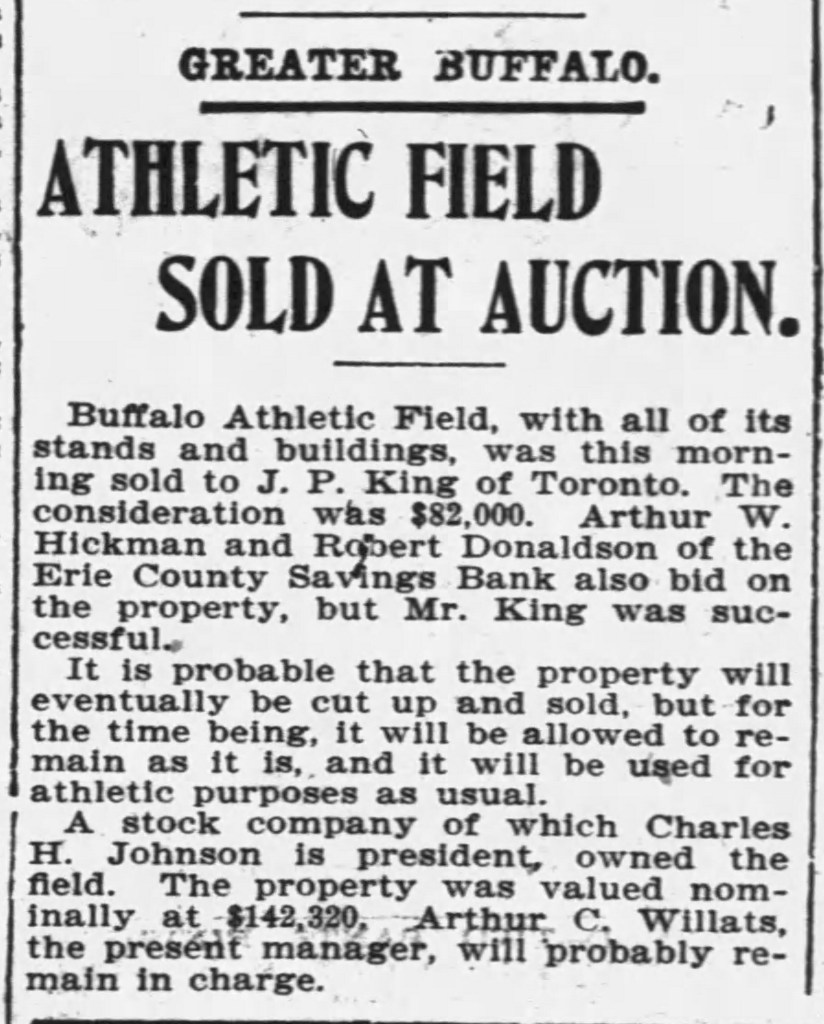
Arthur was mentioned in an article called, “ATHLETIC FIELD WILL NOT BE CHANGED.” which was printed in The Buffalo Courier, on Friday 28th September 1900.
It reads,
ATHLETIC FIELD WILL NOT BE CHANGED
Was Sold Yesterday to J. D. King of Toronto- New Owner Says It Will Continue to Be Used as an Outing Park.
Yesterday afternoon the sale of the Buffalo Athletic Field was consummated but it will be pleasing news to the army of athletes and sport followers in this community to know that it's not going to be subdivided into building lots, but will continue to fill its present sphere.
C. A. Johnson, the Eastern capitalist has been the owner of this property, valued at better than $150.000, but a multitude of other affairs has occupied his entire attention and he thought it best to rid himself of the Bufalo holdings. J. D. King of Toronto is the new purchaser and he paid $82,000 for the property.
On July 11, 1896, under the management of Arthur C. Willats, the field was first opened to the public, and since that time it has been a phenomenal success, thanks to the untiring efforts of a capable manager.
The field has been the screen of many contests that have stiffed the blood of thousands.
Its football, quarter-mile cement bicycle track and other features have for four years attracted the people in goodly numbers. 0n the track known from one end of the country to the other, more world's records have been made than on any other single track in America.
Manager Willats has been untiring in his efforts to make the track a success and he succeeded. He is a capable and one well versed in the art of catering to the fancy of a fickle public. and that the field was a success at all is due entirely to him. Of all the meetings held at he field this year but two were unsuccessful, the national championship meeting conducted a few weeks ago by the Ramblers Club and poor weather caused a loss here.
After outbidding several other eager participants yesterday. Mr. King said:
''For at least two years the Field will remain as it now is. I have purchased it
merely as a speculation and I believe it to be a good one. I do not propose to deprive Buffalonians of the Field at the very outset, but, of course if at the end of two years I find that it is not as profitable as it has been 1 shall subdivide it and dispose of it in that way.”
Among the real estate men in the city much surprise was expressed that this place should have been sold at that figure before stated. It is one of the most extensive plots of ground on Main Steet and if some of the other bidders had.secured it there is but little doubt that I would have been cut up and sold.
Mr. Willats will in all probability be continned as the marager of the Fields. His knowledge of all the minute details make him a valuable man and the patrons of the game will be glad to note his retention.

Arthur was mentioned in an article called, “Manager A. C. Willats Arranging a Big Bicycle Match for Buffalo Athletic Field.” which was printed in, “The Buffalo Commercial”, on Tuesday, 30th April 1901.
It reads,
Manager A. C. Willats Arranging a Big Bicycle Match for Buffalo Athletic Field.
RACING MEN ARE TRAINING
Newhouse, Stevens, Denny, Denniston, Zurbrick, Dahike and Others at the Track.
Arthur C. Willats, manager of Buffalo Athletic Field, expects to receive word today from Jimmy Michael, who is in the vicinity of Boston, stating that he (Michael) has accepted terms for 20-mile race with Ray Duer, to take place at Athletic Field May 23rd.
This will be the opening day at Athletie Field, and the Michael-Duer race will be a corker.
Michael has quit the thoroughbreds for the wheel and is pretty clever at 20-mile goes, but Duer's friends are confident that he can beat the *Welsh Rarebit." Duer certainly has acquitted himself with credit during the past two years, and if his machines go along smoothly he will give Michael a hard rub.
Duer is training assiduously at the Athletic Field and he has plenty of company.
Al Newhouse, who is the best sprinter in Buffalo, is plugging along and is showing a good bit of speed. He is expected to carry Buffalo's, colors to the front just like Bald used to years gone by. "Doggie" Stevens has quit building freight cars for the New York Central and has put on his racing togs again, and is surprising his friends by turning quarters under 30 seconds and eighths in 13. Big Freddie Denny is also blossoming forth as fit company for Newhouse and Stevens on the track.
Little Eddie Denniston appeared on the track mounted on a 17-pound pierce, equipped with 3-4-inch tires, and he made a neat and natty showing. The wheel is small enough to use for a watch charm, and the tires resemble the old-time hard ones more than anything else.
Warren Zurbrick is another one of the old timers getting in grand form, and Billy Colson is burning up the track.
Many are picking Colson for first place. Fred Dahlke, who has been unfortunate in falling on the board floor, is coming to the front.
Bruises, scratches and broken limbs do not disturb the tall German and he is holding the fastest pace of the season!
"Skinny" Brendle has also opened the eyes of the "picket birds," as the rooters who line the fence are called.
There are many green ones at the Field, and Willats predicts a big season Training tickets, costing $3 instead of $5 are out. By reducing the price Willats expects to gain many recruits to the army of racing cyclists.
Buffalo Athletic Field will be selected as the training grounds for all the foreign and American cycling and athletic cracks who are going to compete at the Pan-American Stadium.
The facilitie for training at the Pan-Am are limited, and Willats is booking all the notable for his place. F. Ed. Spooner, the note cycling writer, and manager of Johnny Nelson, the champion middle-distance rider of the world, has asked for date for Nelson.
Tom Eck, the grey-haired trainer, will send Bobby Walthour here with eight men and four machines, the biggest crew carried by any man.

Arthur was named in the sport’s section of the Buffalo Courier Newspaper on the 11 May 1901. It reads,
ATHLETIC FIELD YESTERDAY CHANGED OWNERSHIP
Manager Arthur Willats’ Services Will Be Retained by the New Lessees.
Finn & Chretien of bicycle, phonograph, and sporting goods game, have added another line to their business.
Yesterday they closed a lease of the Buffalo Athletic Field for one year. retaining the services of Mr. Arthur C. Willats who for the past six years has ably managed this most popular resort.
Several contracts with the very top-notchers in racing games have already been closed, the first of which will take place on May 23d, when the champion middle-distance rider, Johnny Nelson will meet the well-known local river, Ray Duer, in a Fifteen-mile motor paced race, this race will be paced by four of the latest constructed motor tandems.
The Decoration Day meet as of the past will be run by the Parkside Wheeling CIub and on June 4th. the wonderful Iittle Rarebit Jimmie Michael will ride a twenty-mile motor paced race. This will be his frst appearance in the city since 1897, when he defeated Fred Titus and in which race he made the world record for one mile, 1:37 2-5, which stood until Elkes beat it upon this track in 1899.
Other races of like magnitude will be the order of business during this season.

Arthur was mentioned in an article called, “NELSON RAN AWAY AND WON FROM DUER.” which was printed in The Buffalo Enquirer on Friday, 24th May 1901.
It partly reads as follows,
NELSON RAN AWAY AND WON FROM DUER
Beat the Buffalo Rider More Than a Mile in the Fifteen Raced Last Night.
As predicted by those who have been watching, the two riders for the past few weeks, Johny Nelson the great pace follower last night in his match race with Ray Duer of this City simply ran away from the Buffalo boy and won out by over a mile in the fifteen scheduled to be raced.
Duer did the best possible for the condition he was in, but he owes it to the public, as well as himself, that he get in better shape the next time he races a man of the caliber of Neilson.
Last night's races were the first electric light events of the year and Manager Willats of the Field was encouraged by the fairly good crowd present.
From all indications one of the best seasons financially in cycle racing during the past six or severe years is sure to be this summer. In the main event last night Nelson caught his pace first and never afterward was headed. His work was simply magnificent and despite the fact that he was riding a local champion Nelson's gameness and fast riding so impressed the crowd, that he was applauded again and again to the echo.
The results of last night's events were as follows:
First mile .… 1:51
Second mile .…. 3:24 2-5
Third mile .…4:58
Fourth mile …. 6:35
Fifth mile .… 8:09 4-5
Sixth mile …. 9:45
Eighth mile .… 12:54
Ninth mile .… 14:35
Tenth mile .… 16:05
Eleventh mile .… 17:43 1-5
Twelfth mile …. 19:19 2-5
Thirteenth mile …. 20:56
Fourteenth mile …. 22:31 1-5
Fifteenth mile .... 24:03

Arthur was featured in an article called “WILLATS PROGRAM” which was printed in “The Buffalo Commercial” on Thursday, 27th June 1901.
It reads,
WILLATS' PROGRAM.
Sprints Placed on 4th-of-July's Program-Team Pursuit Race.
Manager Arthur C. Willats has arranged a taking program of bicycles races for his Fourth-of-July meet which will take place at the Buffalo Athletic Field on the afternoon of the National holiday. The open events have been made short so that they will be a sprint from start to the finish. The novice is one-quarter mile and the prizes are handsome, better than the first-time-outers have ever raced for before, first prize being valued at $25, second $15, third $10. The open race for amateurs will be one-third mile, a distance that no rider can afford to wait for some one to take the lead; all will want to do that. The team pursuit race is a clever arrangement. It will bring into competition the best three riders of Cleveland, Rochester and Buffalo. As Buffalo cannot defeat Rochester in baseball let it be hoped that this city can find three representatives that can turn the trick on bicycles. Fred Dahlke of the Buffalo Wheeling Club and Al Beam of the Parksides have been doing the better riding among the amateurs during the past season and the ten-mile motor paced race arranged for them just rounds out the program nicely.
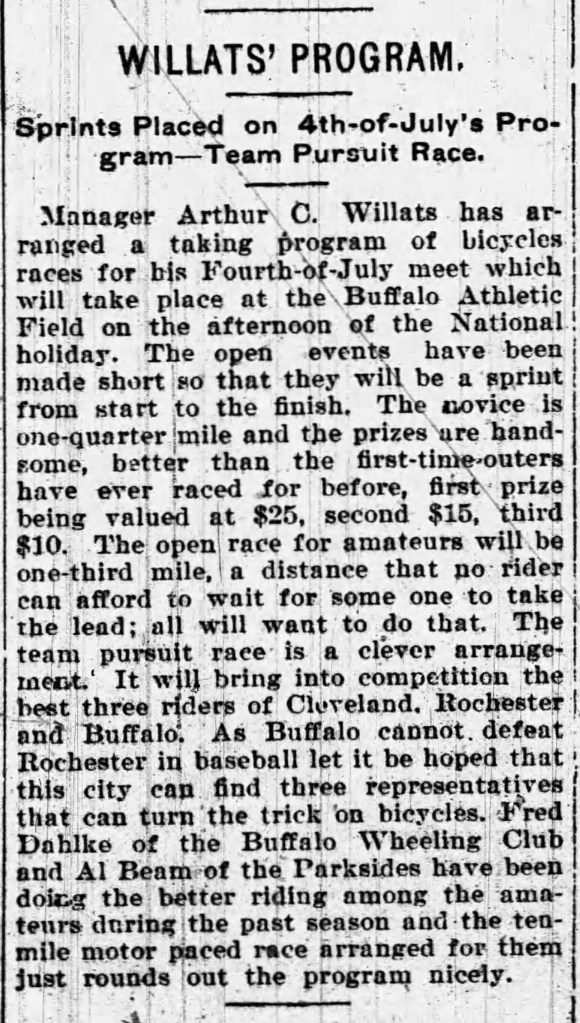
Arthur once again named in the, Buffalo Courier Newspaper, on Monday the 1st of July 1901. It transcribes as follows.
ENTRY LISTS ARE BIG.
Entries for the one-quarter mile novice and the one-third mile open for am-
ateurs, which races are to be run in connection with the team pursuit race between the three representatives of Rochester, Cleveland and Buffalo, the
ten-mile motor-paced race of E. C Beam and Fred Dahike will close tonight with Manager Arthur C. Willat at the office of the Buffalo Athletic Field.
The number of entries for the Fourth of July bicycle meet is far in advance of
previous races, assuring good sport. Race meets of today are principally made up of special features, so that when an opportunity is made for competition the riders seize upon the chance to get in. It has been so in this case, and in each event it will take several heats and a final to decide, the winners. Each heat will make a splendid race, the distance
assuring that fact.
The Stars - that is. those who will perform in special events, are training hard
and guarantee their friends that they will give a good account of themselves on the national holiday. Seats will be found on sale today at the store of A.G. Spalding & Bros.. No. 611 Main Street.

Arthur was mentioned in an article called, “PAID $52.50 FOR SEAT.” which was printed in “The Buffalo Commercial” on Saturday, 28th June 1902 in Buffalo, New York.
It reads,
PAID $52.50 FOR A SEAT.
Arthur C. Willats. who will be remembered as former manager of Buffalo Athletic Field, writes from London, England, that he saw the Erne-Maloney fight, and that his ticket cost $52.50.
In the United States a club could not get 52 cents for admission.

Back in England, Arthur’s sister, Eliza Mary Beach nee Willats died on Monday the 21st of July 1902, at Beach Court, Upper Deals, Eastry, Kent, England, at the awfully young age of 35 years.
Eliza died from Pneumonia and exhaustion.
Edith Cameron Charlton nee Willats, Richards daughter and Eliza sister, was present and registered her death on the same day, Monday the 21st of July 1902.
Edith stated the Eliza was the wife of Benjamin Beach, giving his profession as, independent means.
Eliza’s death was registered under the name Mary Eliza Beach.

Eliza Mary Beach nee Willats was laid to rest, on Thursday the 24th July, 1902, at St Peter Church, Thanet, Kent, England.
From the available Passenger lists it looks like Arthur didn’t attend.
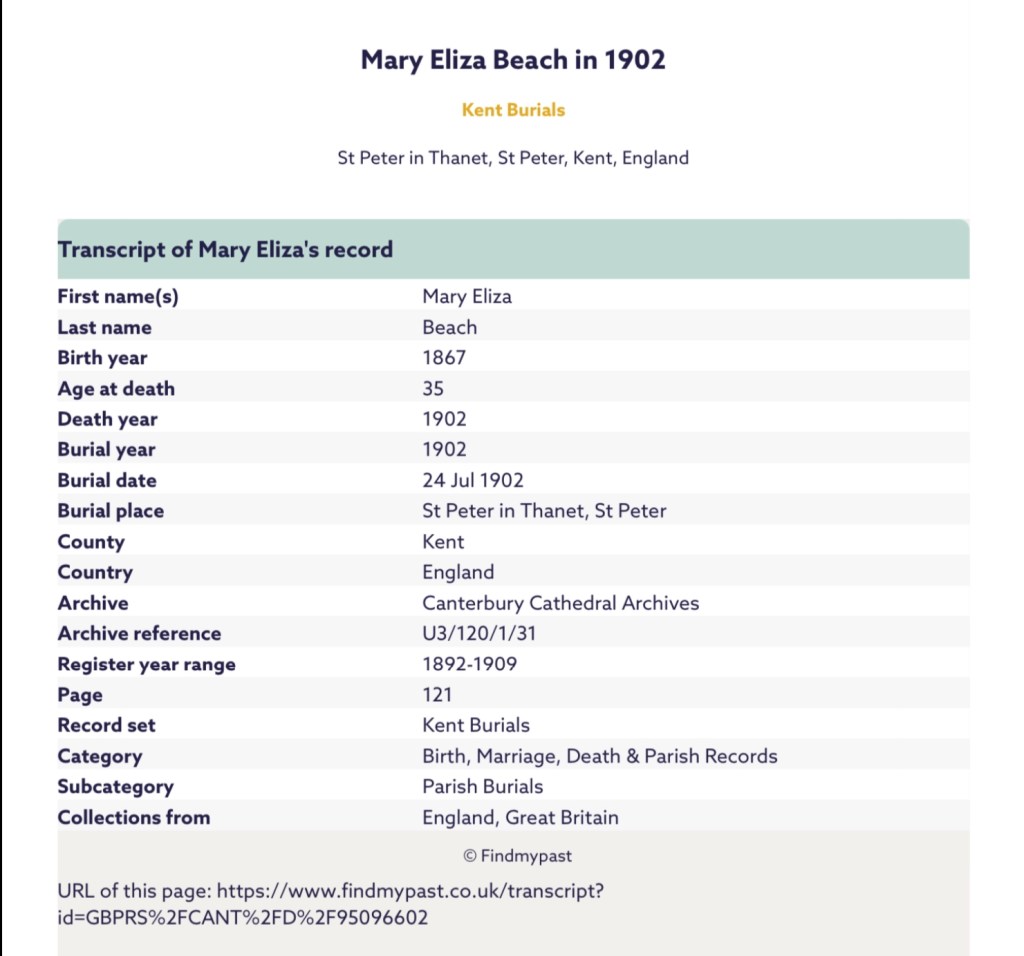
St Peter’s is an area of Broadstairs, a town on the Isle of Thanet in Kent. Historically a village, it was outgrown by the long-dominant settlement of the two, Broadstairs, after 1841. Originally the borough or manor of the church of St. Peter-in-Thanet, it was said to be the largest parish east of London, at least until Broadstairs became a separate parish on 27 September 1850. The two settlements were formally merged administratively in 1895. The village and its church, named after Saint Peter, was the second daughter church of Minster established in 1070, although the first written record of its present name dates to 1124. In 1254 the village was named “scī Petr'”, which gradually changed to “scī Petri” by 1270, Sti Petri in Insula de Thaneto by 1422, and finally settling by 1610 on its current form of St Peter’s. The church has the right to fly the white ensign, dating from when the church tower was used as a signalling station in the Napoleonic Wars. The village sign won first prize in a nationwide competition in 1920. Edward Heath, leader of the Conservative Party from 1965 to 1975, serving as prime minister from 1970 to 1974, was born in the village in 1916. On 27 April 1952, a United States Air Force Republic F-84 Thunderjet from RAF Manston crashed in the main street with loss of life.
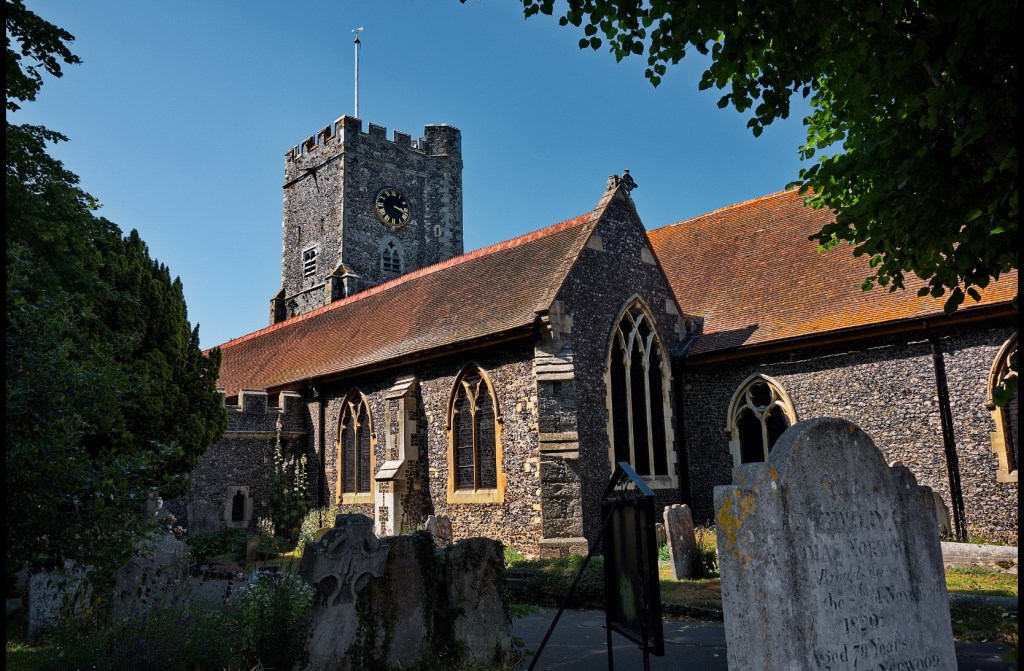
However Arthur did visit his birth country in 1902 as the next document I have for Arthur is The Uk and Ireland, our ward passengers list.It shows, that on the 15th of November 1902, Arthur, his wife Josephine and their two children, Beatrice and Richard, left Southampton Docks, Southampton, Hampshire, England, aboard the ship “St Paul”, to New York, United States of America.
It states that Arthur was a 45-year-old, Clark. Josephine was 48-years-old, Beatrice was 10-years-old and Richard was 7-years-old.
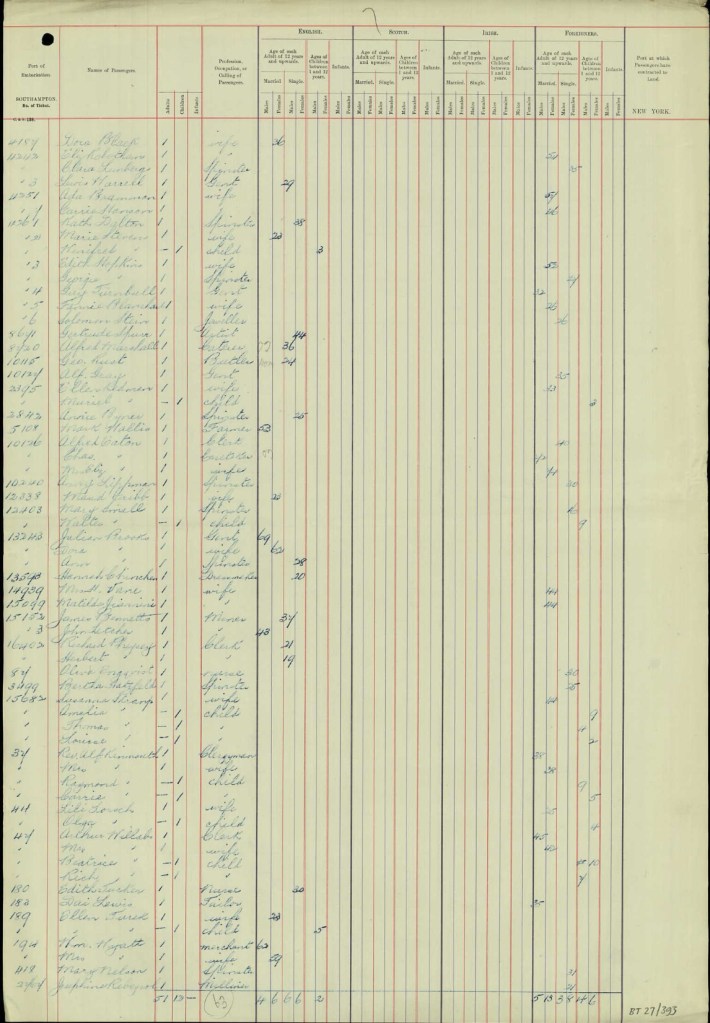
SS Saint Paul was a trans-Atlantic ocean liner named for the capital of Minnesota.
SS Saint Paul was launched on 10 April 1895 by William Cramp & Sons, Philadelphia, as a steel passenger liner. The ship later was chartered for United States Navy service as an auxiliary cruiser from her owner, International Navigation Company, by a board appointed on 12 March 1898; and commissioned on 20 April 1898 for Spanish–American War service, Captain Charles D. Sigsbee in command.
Departing Philadelphia on 5 May 1898, Saint Paul’s first assignment was to cruise in search of Admiral Cervera’s squadron between Morant Point, Jamaica, and western Haiti. She captured the British collier Restormel—bound for Cuba with a critical cargo of Cardiff coal—on 25 May and sent her into Key West under a prize crew. She cruised off Santiago de Cuba and Guantanamo Bay into mid-June, then sailed to join the force blockading San Juan, Puerto Rico.
Saint Paul arrived off San Juan on the morning of 22 June. Shortly after midday, in the second battle of San Juan, the Spanish cruiser Isabel II, emerged from the harbor and, remaining under protection of shore batteries, opened fire on Saint Paul at long range without success. Isabel II was joined shortly by the destroyer Terror, which attempted to close Saint Paul to launch torpedoes. Saint Paul took Terror under heavy fire, scoring at least one direct hit which heavily damaged the destroyer. Terror gave up the attack and returned to port, followed by Isabel II. Saint Paul was relieved by Yosemite off San Juan on the 26th and made for New York to coal.
Saint Paul spent the remainder of her Spanish–American War service as a transport, operating for 48 days in July–August as a War Department vessel. She landed troops at Siboney, Cuba, and Arroyo, Puerto Rico, subsequently returning soldiers from Guantanamo Bay to New York City through 15 August. Entering the Cramp shipyard on 22 August for re-conversion to mercantile service, Saint Paul was decommissioned on 2 September and returned to her owner the same day.
On 25 April 1908, outward bound from Southampton, England, in a late snowstorm, Saint Paul was involved in a collision with the British cruiser HMS Gladiator in the Needles Channel. Gladiator foundered in shallow water with the loss of 27 crew, but Saint Paul was able to return to Southampton for repairs.
SS Saint Paul, was in service from 1895 to 1923.
It had 2 Funnels, and 2 Masts.
SS Saint Paul’s tonnage was 11,629, Dimensions: 535′ x 63′, Twin-screw, and could go 21 knots with its Quadruple expansion engines.
It’s maiden voyage was from New York to Southampton, on the 9th of October 1895.
As the United States transport Knoxville, during World War I, she capsized (April 1918) alongside a New York pier.
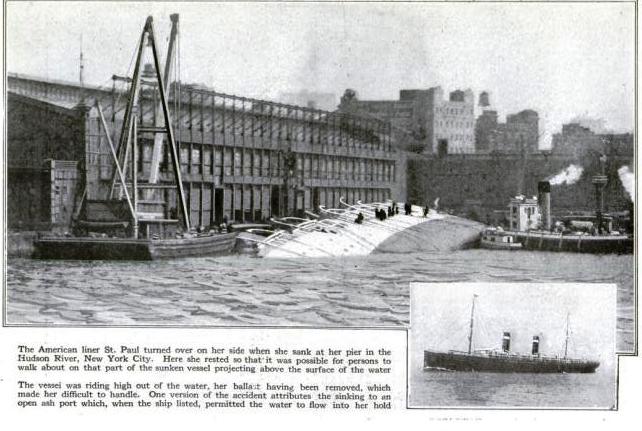
Subsequently refloated and reconditioned for trans-Atlantic service. SS Saint Paul made its re-entry New York-Cherbourg-Southampton run route, in March 1920 and was scrapped in Germany, in 1923.
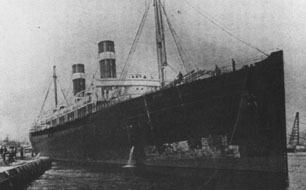
From the U.S directories, we Know that Arthur was residing at, 1689 Main Street, Buffalo, Erie, New York, United States of America, in 1902.


An article about Arthur called “MANAGER WILLATS IS BACK.” was printed in “The Buffalo Courier Express” on Wednesday, 24th December 1902.
It reads,
MANAGER WILLATS IS BACK.
Arthur C. Willats, manager of Buffalo Athletic Field, has returned to Buffalo after a six-month journey through England, France, Ireland and Belgium, mostly England. "Every day was a holiday after I left Buffalo," said Mr. Willats, who has taken up his duties at the field.
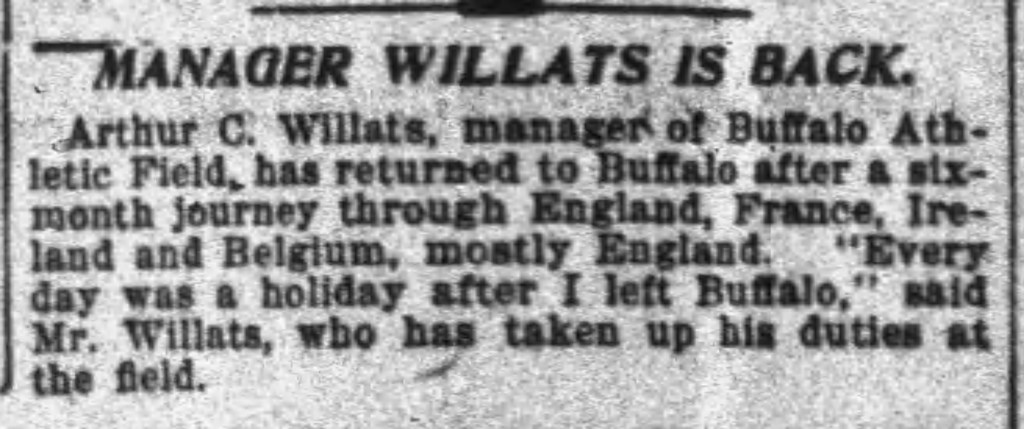
From the U.S City Directories, we know Arthur was residing at, 1689 Main Street, Buffalo, Erie, New York, United States of America, in 1903. The directory gives his occupation as a Natural Rock Filter Co. And the Manager for Buffalo Athletic Field at Number 1903 Main Street. His residence is listed as Number 1689 Main Street.


Arthur was featured in an article called “FUTURE OF BICYCLE RACES.” Which was printed in “The Buffalo Commercial” on Wednesday, 23rd September 1903.
It reads,
FUTURE OF BICYCLE RACES.
Arthur C. Willats Says that Sprinting Will Again Become Popular.
Arthur C. Willats, manager of Buffalo Athletic Field, believes in the future of Bicycle Racing. “I hope to see revival in 1904," said Mr. Willats, "with sprinting as the feature. This year the easterners sported the motor-paced races, but they didn't draw. The public favors sprints."
The Athletic Field will be cut into building lots if bicycle races do not pay in 1904.
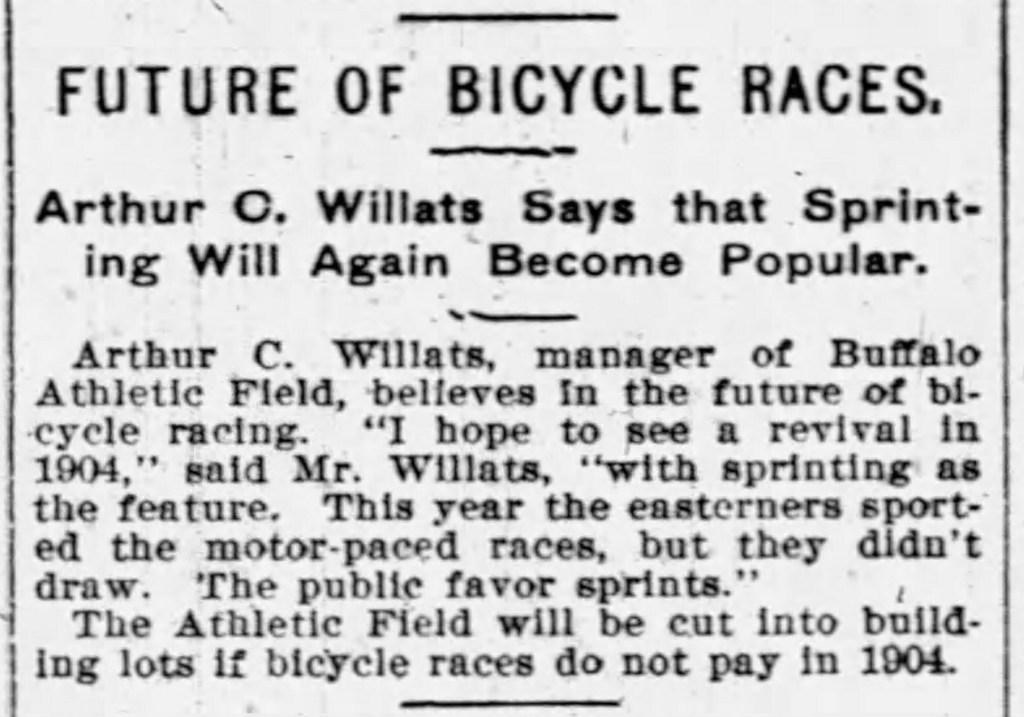
Arthur’s wife Josephine and his sister, Charlotte Crosbie nee Willats, were mentioned in an article printed in The Buffalo News on Thursday, 10th December 1903. Even though Arthur isn't mentioned, I found the article too interesting not to document.
The article reads,
MRS. WILLLATS of 1689 Main st., who recently returned from Europe after taking an eighteen-month course at the famous, London, Eng., electrolysis establishment, adjoining Queens Hall, Langham Place, Regent st., which is, and for the past 14 years has been presided over by Mrs. Crosbie, who numbers among her patients many of the royalty and nobility of England, and who found in Mrs. Willats an able assistant and made her sole American representative for her famous preparations: Mrs. Willats is now prepared to receive by appointment a few select patients for hygenic and electrical face treatment.

Practically, the same article was printed in the Buffalo news on the 11th, 12th 14th, 15th, 16th, 17th, 18th, 19th, 23rd, 24th, 26th, 27th, 28th and 29th of December 1903.
Arthur was named in an article called, “Enjoyable Program” which was printed in “The Buffalo Times” on Sunday, 17th January 1904.
It reads as follows,
Enjoyable Program
The following Interesting program has been arranged for tomorrow's meeting of the Daughters of the American Revolution to be held at the Twentieth Century Club:
Song--"America" …………..
Devotional Exercises.
Reading of the minutes of previous meeting, by the secretary Mrs. Richard Wallace Goode.
Business.
Vocal Solo —
(a) "I'm alone" …… Benedict
(b) "Aime Mol"' …... Chopin-Viardot
Mrs. Elizabeth Hoffman Mesmer.
A sketch of Martha Washington……..
Mrs. Homer E. Dudley.
Duet. (a) "Mid Budding Branches" ……. Edwin Schultz
(b) "Hark to the Mandollne" ……. Henry Parker
Mrs. Mesmer-Miss Lavinia S. Hawley.
Address by the regent of the chapter, member of the board of lady managers, on the
Louisiana Purchase Exposition.
Followed by a "Talk on Exhibitions and Expositions " by M. Richmond C. Hill, secretary Buffalo World's Fair Exhibit Committee. Illustrated by stereopticon views shown by Mr. Arthur Willats.
The hostesses are: Mrs. Albert E. Jones, Mrs. John C. Adams, Miss Harriet M. Buck, Miss Annie E. Burrows. Mrs. Charles Bosche, Mrs. G. Hunter Bartlett, Mrs. Walter Devereaux, Mrs, John L. Evans. Mrs. James F. Foster, Miss Virginia Granger, Walter J. Shepard, Mrs. John C. Thompson, Mrs. James P. Wilson, Mrs. C. B. Williams, Mrs. Harry Walbridge.

Arthur was mentioned in an article on page 3 of “The Buffalo Evening News”, called “Today’s Meeting of the Daughters.”, on Monday, 18th January 1904.
It reads,
Today's Meeting of the Daughters.
This afternoon at 3 o'clock the Buffalo Chapter, Daughters of the American Revolution, will hold its January meeting in 20th Century Club Hall.
Mrs. John Miller Horton, the regent of the chapter, will present the idea of a colonial tea to celebrate the next anniversary of the foundation of the chapter, March, 12, 1904.
The programme includes a character sketch of Martha Washington by Mrs. Homer E. Dudley; music by Miss Lavinia S. Hawley and Mrs. Elizabeth Hoffman Mesmer; an address by the regent of the chapter, Mrs. John Miller Horton, member of the board of lady managers on the Louisiana Purchase Exposition. Followed by a "Talk on Exhibitions and Expositions," by Mr. Richmond C. Hill, secretary Buffalo World's Fair Exhibit Committee. Illustrated by stereopticon views shown by Mr. Arthur Willats.

A stereopticon is a slide projector or relatively powerful "magic lantern", which has two lenses, usually one above the other, and has mainly been used to project photographic images. These devices date back to the mid 19th century,[1] and were a popular form of entertainment and education before the advent of moving pictures.
Magic lanterns originally used rather weak light sources, like candles or oil lamps, that produced projections that were just large and strong enough to entertain small groups of people. During the 19th century stronger light sources, like limelight, became available.
For the "dissolving views" lantern shows that were popularized by Henry Langdon Childe since the late 1830s, lanternists needed to be able to project two aligned pictures in the same spot on a screen, gradually dimming a first picture while revealing a second one. This could be done with two lanterns, but soon biunial lanterns (with two objectives placed one above the other) became common.
William and Frederick Langenheim from Philadelphia introduced a photographic glass slide technology at the Crystal Palace Exhibition in London in 1851. For circa two centuries magic lanterns had been used to project painted images from glass slides, but the Langenheim brothers seem to have been the firsts to incorporate the relatively new medium of photography (introduced in 1839).To enjoy the details of photographic slides optimally, the stronger lanterns were needed.
By 1860 Massachusetts chemist and businessman John Fallon improved a large biunial lantern, imported from England, and named it 'stereopticon'.
For a usual fee of ten cents, people could view realistic images of nature, history, and science themes. The two lenses are used to dissolve between images when projected. This "visual storytelling" with technology directly preceded the development of the first moving pictures.
The term stereopticon has been widely misused to name a stereoscope. The stereopticon has not commonly been used for three-dimensional images.

Arthur’s wife Josephine was also mentioned in an advertisement on page 10 of The Buffalo Evening News on Monday, 18th January 1904.
It reads,
MRS. WILLATS of 1689 Main st. has had compounded three of Mrs. Crosbie’s famous English preparations, which are used among the most beautiful women of Europe: Carola Face Emulsion and the famous Creme, which is really nature's secret for a clear and beautiful complexion, all of which can be sent by mail to any address; Mrs. Willats will receive by appointment a few more select patients for hygienic and electrical face treatment.

From the U.S City Directories, we know Arthur was residing at, 1689 Main Street, Buffalo, Erie, New York, United States of America, in 1904. The directly entry also shows a W (which either means Westside or Work/occupation) and Athletic Field.


Arthur was mentioned in an article called “AL WEINIG’S FALL.” which was printed on page 12 in the “LATEST SPORTING GOSSIP, BY LONG SHOT” section of “The Buffalo Times”, on Thursday, 25th February 1904.
It reads,
AL WEINIG'S FALL.
Imagine Al Weinig with his slim body and long legs in Arthur Willats' pants.
What a picture it must have made. Al was out for a walk last Sunday and while in the vicinity of Mr. Willats' residence on North Main Street, he stepped into a puddle of water.
One foot described a circle and hit one of the street railway company's trolley wires, while Al succumbed to the force of gravitation and landed flat in the deep pool of dirty water.
He got up and after wringing himself out as much as he could hiked for Mr. Willats’ home. Now Mr. Willats is in Elmer Hoover’s class, and when Al dressed up in the borrowed pants and sweater he looked like a combination of "Billy Bounce" and "Simple Simon." At least Charley Filbrick says so, for he saw Al in Willats' generous garments and he's been laughing ever since.

The following year Arthur’s wife, Josephine, sadly passed away on the 25th of January 1905, at Number 304 Main Street, Buffalo, New York, USA, at the age of 39. They had been married 19 years.

Arthur was mentioned in an article called “DIED IN DENTIST’S CHAIR.” about his wife Josephine's death which was printed on page 1 of the 12 o’clock addition in The Buffalo Evening News on Wednesday, 25th January 1905. Josephine was also named in the “Died” collum further down the page.
They read,
WOMAN DIED IN
DENTIST'S CHAIR.
Mrs. Josephine Willats, 50 years old, died suddenly in the dental parlors at 304 Main street late yesterday afternoon. She was seated in a chair waiting to have a tooth extracted when she was stricken with heart disease. Dr. C. Frank Bruso was called and artificial respiration was tried, but with no avail. The woman died without regaining consclousness. Mrs. Willats lived at 1689 Main street. Medical Examiner Danser was called.
And
WILLATS On Tuesday 24 in isnt., Mary Josephine Willats nee Conley, wife of Arthur C. Willats and mother of Beatrice and Richard. Funeral from her mother's residence, 596 Masten Street.
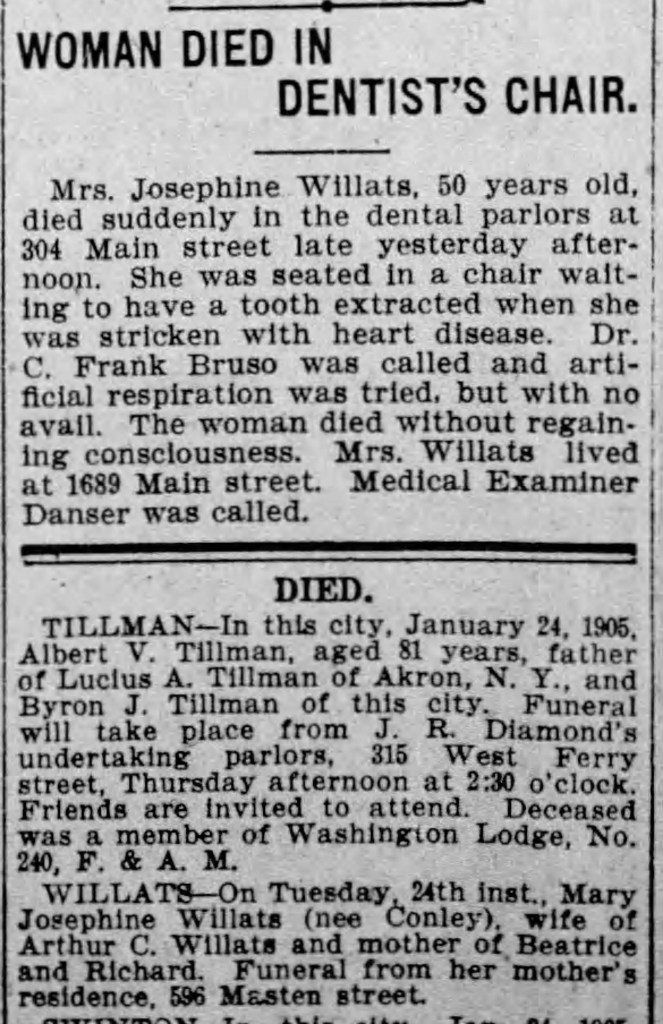
The Buffalo Commercial, also wrote an article about Arthur’s wife Josephine's death on Wednesday, 25th January 1905. The article was called “DIED IN DENTIST’S CHAIR.” and it reads as follows,
DIED IN DENTIST'S CHAIR.
Mrs. Arthur C. Willats, 50 years old, of 1689 Main Street, died yesterday afternoon in the Albany Dental Parlors at 304 Main Street.
Mrs. Willats went to the dental parlours yesterday afternoon and seated herself in the dentist's chair. The dentist was about to administer gas when Mrs. Willats toppled over in the chair. Dr. C. Frank Bruso of 380 Main Street was summoned, but the woman died before he got there.
Dr. Earl G. Danser, medical examiner, was notified. He said death was due to heart disease.

An article about Arthur's wife Josephine's death was printed in The Buffalo Courier Express on Wednesday, 25th January 1905.
It reads,
DIES IN DENTIST'S CHAIR.
Josephine Willats succumbs as Doctor was about to administer Gas.
Josephine Willats, 50 years old, of No. 1689 Main street, died in a chair at the dental parlors at No. 304 Main Street yesterday afternoon. All attempts at artificial respiration proved fruitless.
The dentist was about to administer gas when the woman suddenly toppled over In the chair. He ran for assistance and found Dr. Bruso, who worked over the woman for some time. The dentist said that he had not administered any gas, but was about to do so when the woman collapsed.
Dr. Danser, medical examiner, was called and said that death was due to heart disease.

Josephinee Mary Willats Nee Conley, Death Announcement was printed in The Buffalo Evening News on Thursday the 26th of January, 1905. It reads as follows,
WILLATS-On Tuesday, the 24th inst., Mary Josephine Willats, (nee Conley), wife of Arthur C. Willats and mother of Beatrice and Richard. Funeral from her mother’s residence, 596 Masten Street, Friday morning at 9 o’clock, and from Our Lady of Lourdes Church, Main and Best Street,
at 9:30 o’clock. Friends are respectfully invited to attend.
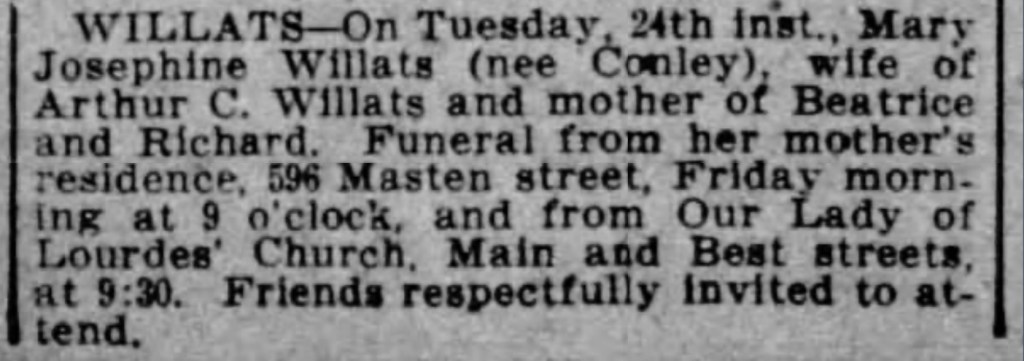
It was also printed in the The Buffalo Enquirer on Thursday 26th January, 1905.
DIED
WILLATS- On Tuesday, the 24th in St, Mary Josephine Willats, (nee Conley),
wife of Arthur C. Willats and mother of Beatrice and Richard. Funeral from her mother’s residence, No. 596 Masten Street, Friday morning at 9 o’clock, and from Our Lady of Lourdes Church, Main and Best Street, at 9:30 o’clock. Friends are respectfully invited to attend.

Also in the Buffalo Courier Newspaper on Thursday 26th January 1905. It reads,
DIED.
WILLATS - Tuesday, January 24, 1905, Mary Josephine Willats (nee Conley), wife of Arthur C. Will at S, and mother of Beatrice and Richard Willats. Funeral from her mother’s residence, No. 596 Masten Street.

A tribute to Arthur’s wife, called “MANY FRIENDS MOURN MRS. ARTHUR WILLATS.” was printed on page 10, of The Buffalo Evening News, on Thursday, the 26th of January 1905.
It reads,
MANY FRIENDS MOURN MRS. ARTHUR WILLATS.
The sudden death of Mrs. Arthur C, Willats which occurred Tuesday last, was a terrible blow to her family and friends.
Mrs. Willats was 41 years and 10 months old and born at Niagara Falls, Ont. She leaves a husband and two beautiful children, Beatrice Josephine, 14 years old, and Richard Henry, 12 years old, also her mother, Mrs. P. Conley of Masten street; a brother. Ed J., and three married sisters, Mrs. Allen Hart, Mrs. Hugh S. Thompson and Mrs. William Haskin. Mrs. Willats came to her death through heart disease in a Main Street dental establishment, where she had gone to have two teeth extracted. Mrs. Willats will be buried tomorrow morning from her mother's home, 596 Masten Street, and half an hour later from later from Our Lady of Lourdes’ Church, Main and Best streets.
Mrs. Willats was an adorable wife and mother, a sweet, true friend and many friends extend their heartfelt sympathies to Mr. Willats and family.
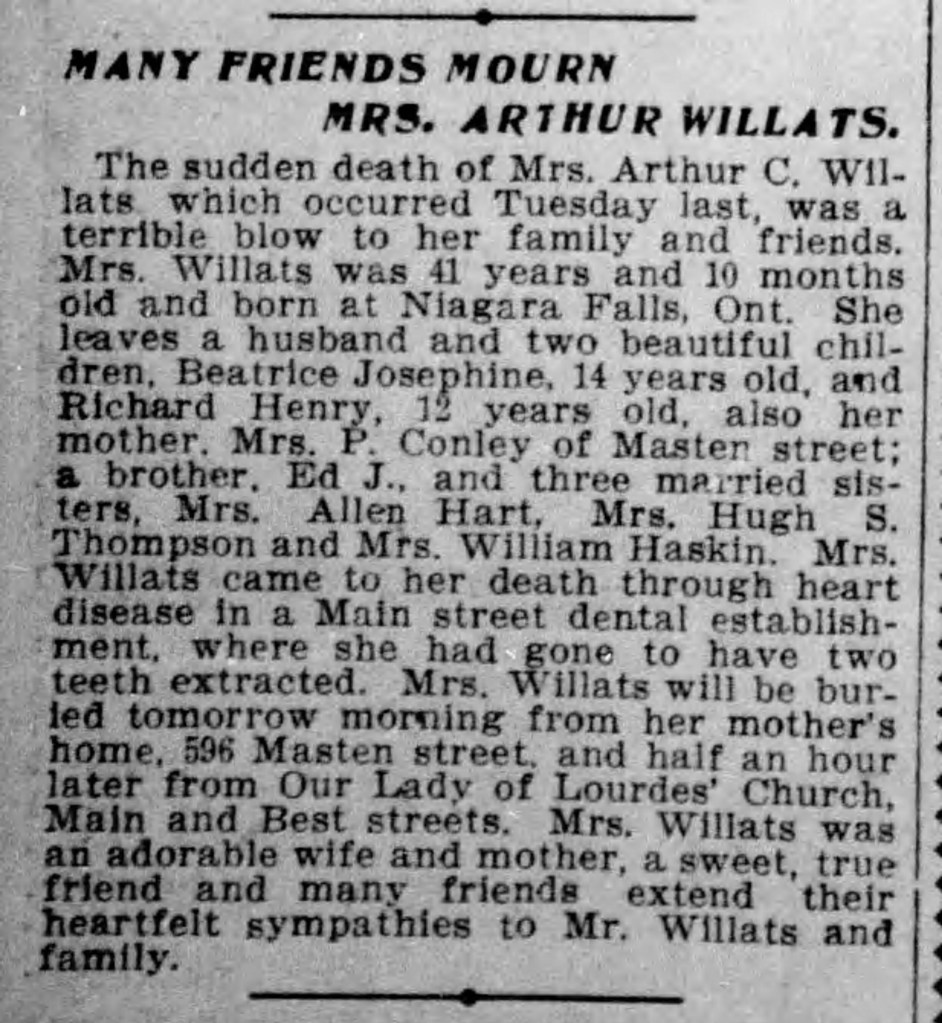
On Friday 27th January 1905, at 9 o’clock in the morning, Arthur, his children Beatrice and Richard and family gathered at Arthur’s mother-in-law home, 596 Masten Street, Buffalo, where they left to attend Josephines funeral which was held at Our Lady of Lourdes Church, Main and Best Street, Buffalo, Erie, New York, USA, at 9:30 o’clock.
Our Lady of Lourdes traces its history to the 1832 founding of Lamb of God, Buffalo's first-ever Roman Catholic congregation. French-Americans made up a sizable portion of Buffalo's population in the very earliest days of its history - a prominent founding citizen (and Lamb of God's founder) was Louis LeCouteulx de Caumont, a prominent banker and nobleman who settled in the city after fleeing the Revolution - but the massive waves of German, Irish, and later Polish immigrants were the communities that came to demographic dominance over the second half of the 19th century. Our Lady of Lourdes, the home church of Buffalo's Franco-American community after the breakup along ethnic lines of Lamb of God's congregation, was accordingly never a flock of impressive size. The parish was dissolved in 1993 as part of a reorganization of inner-city Catholic congregations
At present the church undergoing redevelopment as apartments.

Arthur, laid his wife Josephine Mary Willats nee Conley, the mother of his children, Beatrice and Richard, to rest on Friday the 27th of January 1905, at Holy Cross Cemetery, 2900 South Park Avenue, Lackawanna, Erie, New York, United States of America, NY 14218, in plot quarter C.



Holy Cross Cemetery was officially opened in 1849 as a parish cemetery, although records show burials dating as far back as 1830. In 1853, the cemetery was expanded when Bishop John Timon borrowed $1,200 to purchase a small farm for a cemetery and consecrated 40 acres of it. For this reason, it was noted as being the "Bishop's" cemetery, as title to the property was in his name.
This cemetery's boundaries contain the graves of early Irish immigrants - those who dug the Erie Canal, built the railroads, worked the docks and Great Lake's steamboats and labored at the grain elevators and steel mills. Those who died in tragedies also lie in place here; nine children ranging in age from 12 to 19 and a young fireman who all died in the 1880 wallpaper factory fire on Perry Street in Buffalo; nearly 700 victims of the 1918 flu epidemic; Casimir Mazurek, victim of the 1919 strike violence at a steel plant and Edward R. Lonegrin, a young Irish lieutenant and Fenian solider, killed in the 1866 battle of Ridgeway, Canada.
When Father Nelson Baker, founder of Our Lady of Victory Basilica and Homes of Charity, which borders Holy Cross Cemetery, died in 1936, he was laid to rest in the stretch of cemetery in the shadow of the basilica.
Holy Cross Cemetery is the largest of the Catholic cemeteries in the Diocese of Buffalo, consisting of approximately 191 acres. There are over 130,000 interments in this cemetery with approximately 60 acres of undeveloped land for future cemetery use.
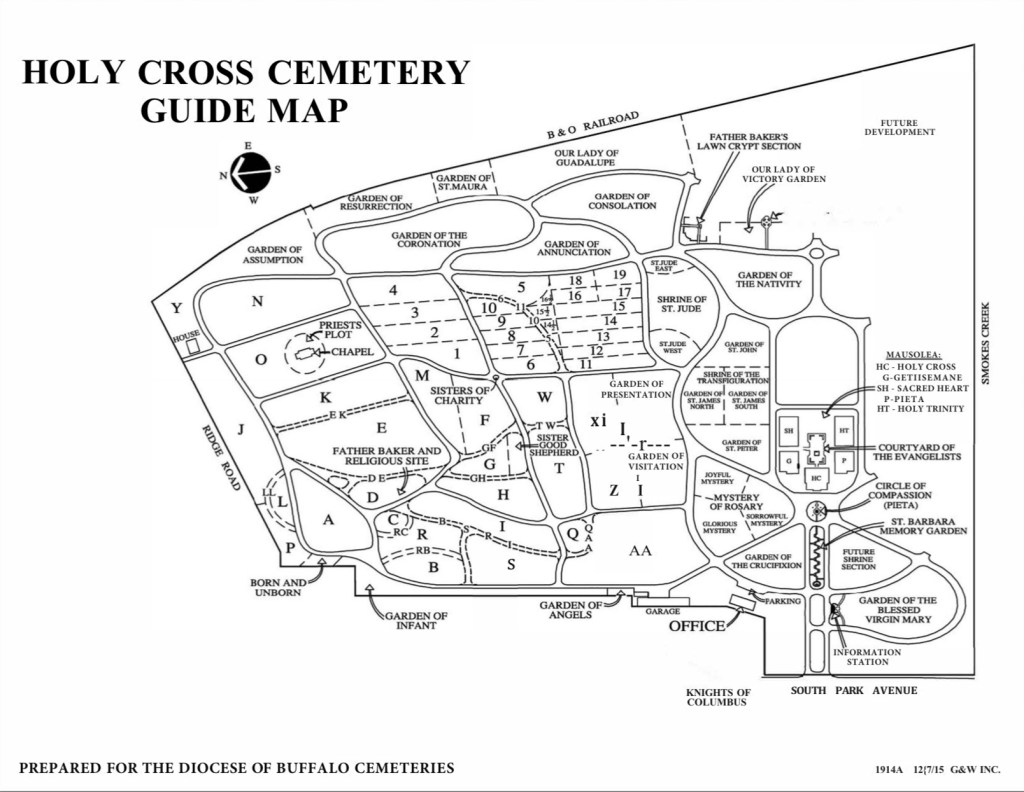
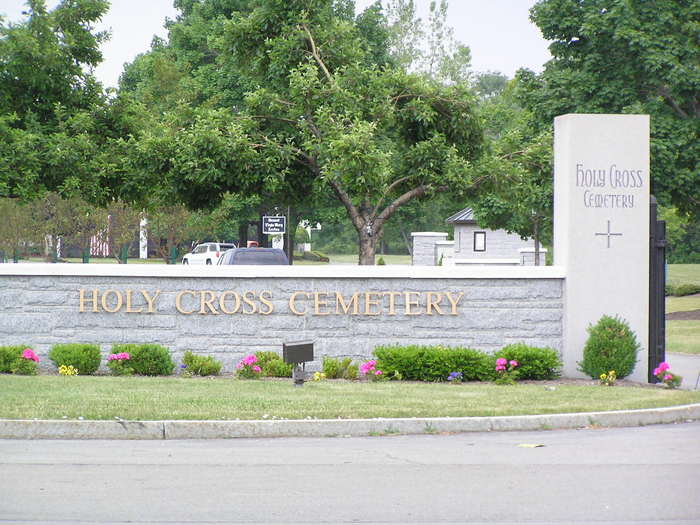
As the pages of Arthur Charles Willats’ life turn, the weight of loss casts a profound shadow over his path. With a heavy heart and the responsibility of two young souls, Beatrice and Richard, his journey through the labyrinth of grief begins. In the next installment, we’ll delve deeper into Arthur’s resilience and the remarkable bond that fortifies this family against life’s storms. Stay tuned as we unveil the resilience and hope that emerge from the depths of their shared sorrow.
Until next time,
Toodle pip.
Your Lainey.
🦋🦋🦋
Amazing research well done
LikeLike